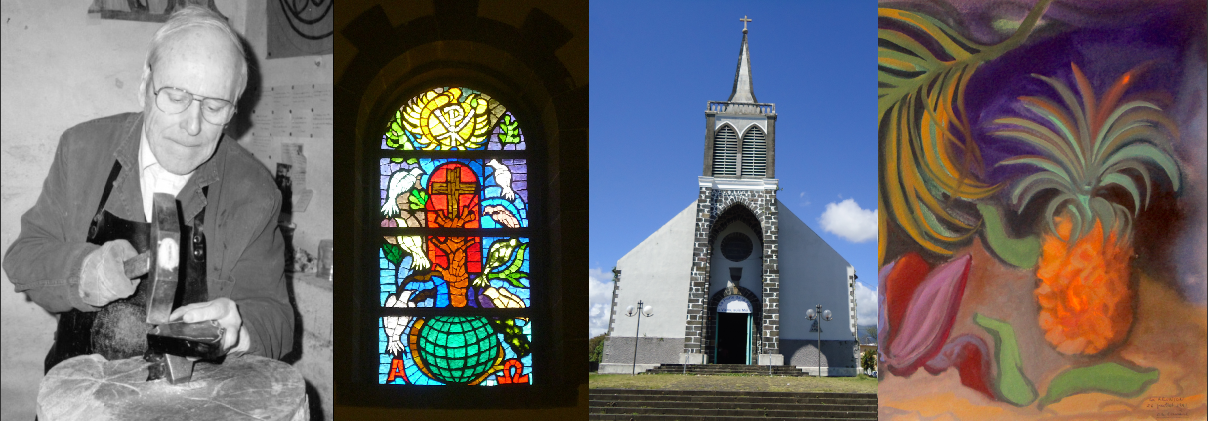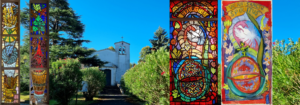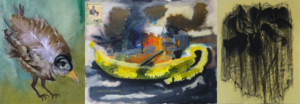FOCUS : Charles Carrère and Reunion Island
In 1987, Réunion was the end of the world !
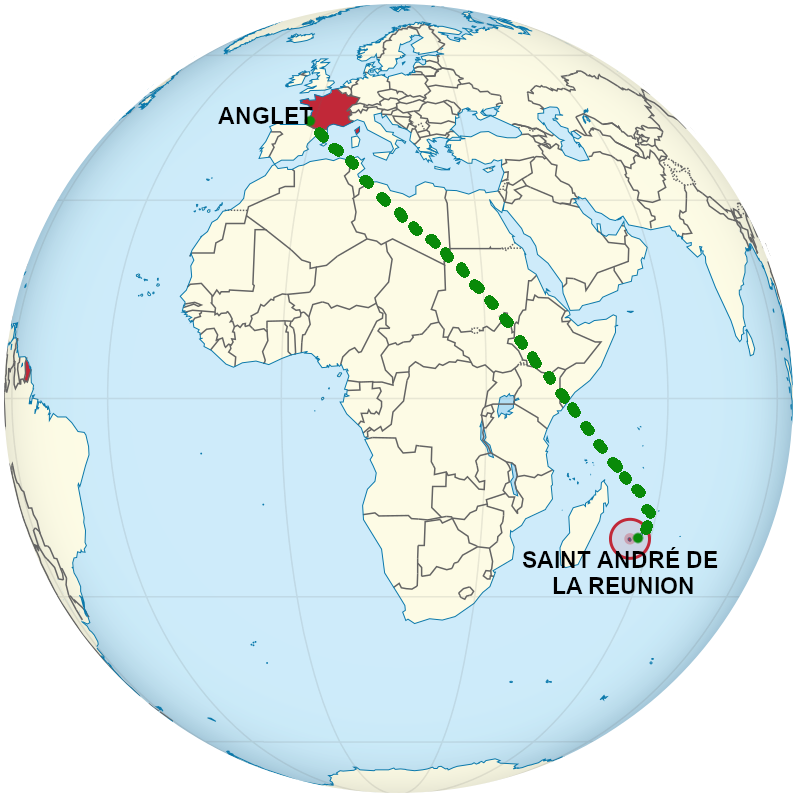
autor M.Bitton
inserting indications@JanieC
In 1987, Father Émile Baptiste is a priest on Réunion, officiating in the church of Saint André in the commune of the same name.
Charles Carrère received a call from Father Emile, whom he knew well because, like him, he came from the northern Basque country. He asked the Master Glassmaker, whose work he appreciated, to send him a few models of stained glass windows he had made in the Basque Country by way of a curriculum vitae. They exchanged quite a few letters… The parish association will also be in contact to define the choice of themes for the stained glass windows.
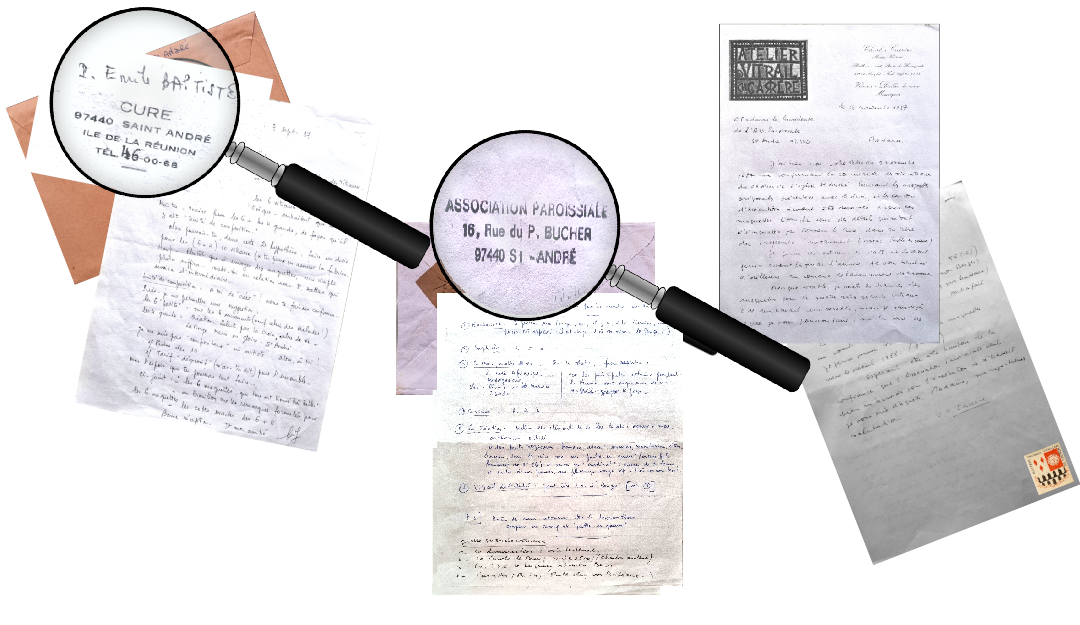
Photos©AssociationCharlesCarrère
Old friends are happy to meet up again. Charles Carrère made the trip because it was essential to take measurements and visit the church to get to know the site and the light. What’s more, meeting and talking live speeds up the decision-making process.
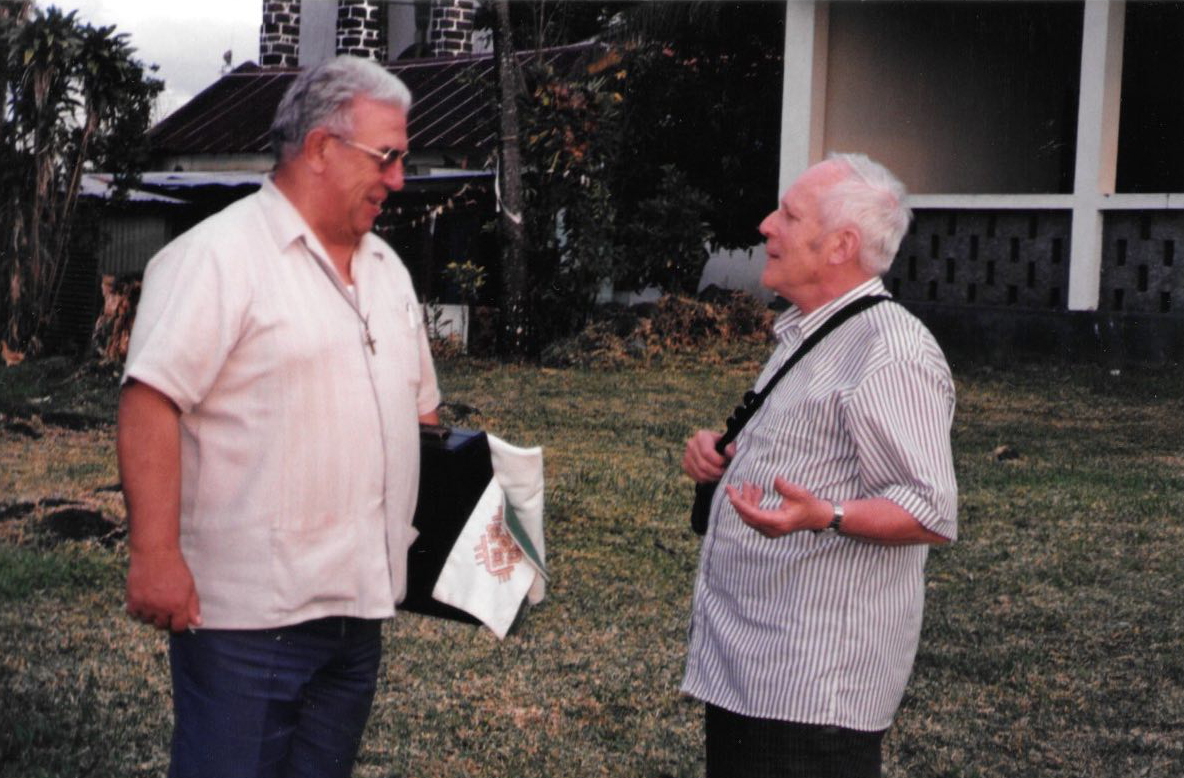
Photo©AssociationCharlesCarrère
Once the themes had been defined, the measurements were taken and the surface area calculated.
The Master Glassmaker’s notes attest to this: in the end, there will be 70.12 m2 of stained glass: 14 stained glass windows and 3 rose windows. Charles Carrère took 3 years to complete the work.

Photo©AssociationCharlesCarrère
There will be many exchanges of letters, with lots of sketches and explanations. The work will be carried out over several years and in two consignments.
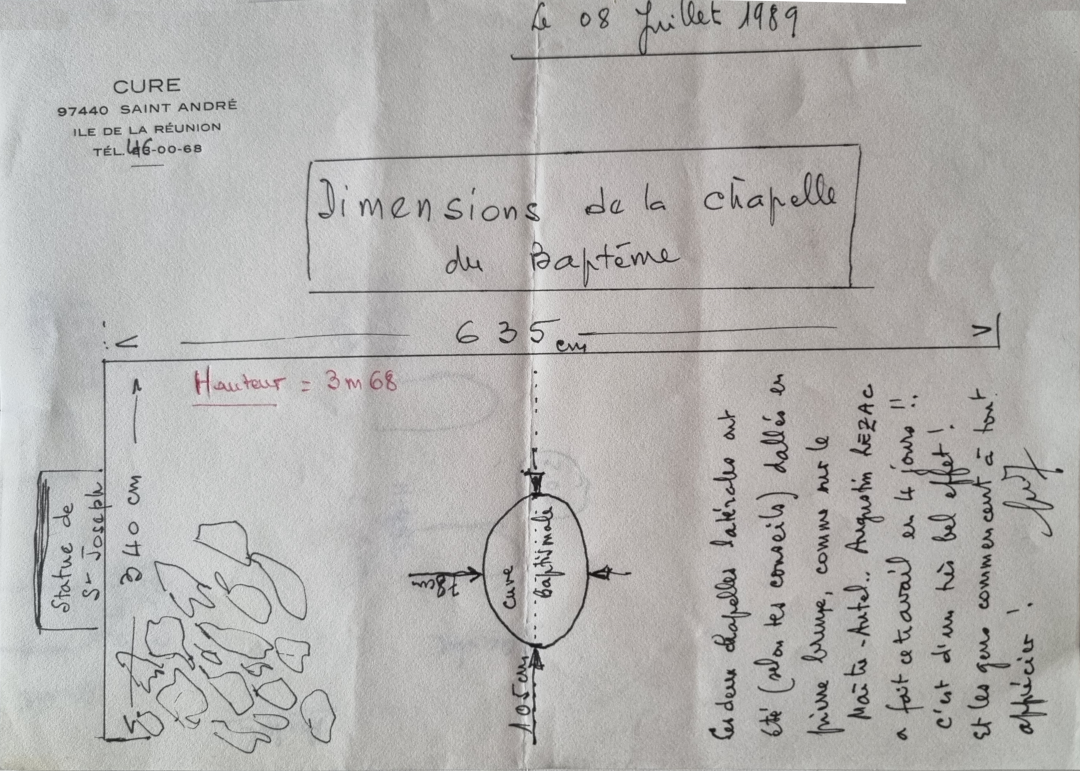
Barely back from his long journey, Charles Carrère set to work in his studio.
For Reunion Island, he creates stained glass windows but without using the lead technique. He’s going to cut glass.
Once the sketches have been drawn and approved, the Master Glassmaker will make a precise 1:1 scale model of each stained glass window. This is a drawing to scale on which he will mark out the locations of the framework, which in this case will be made of cement rather than lead.
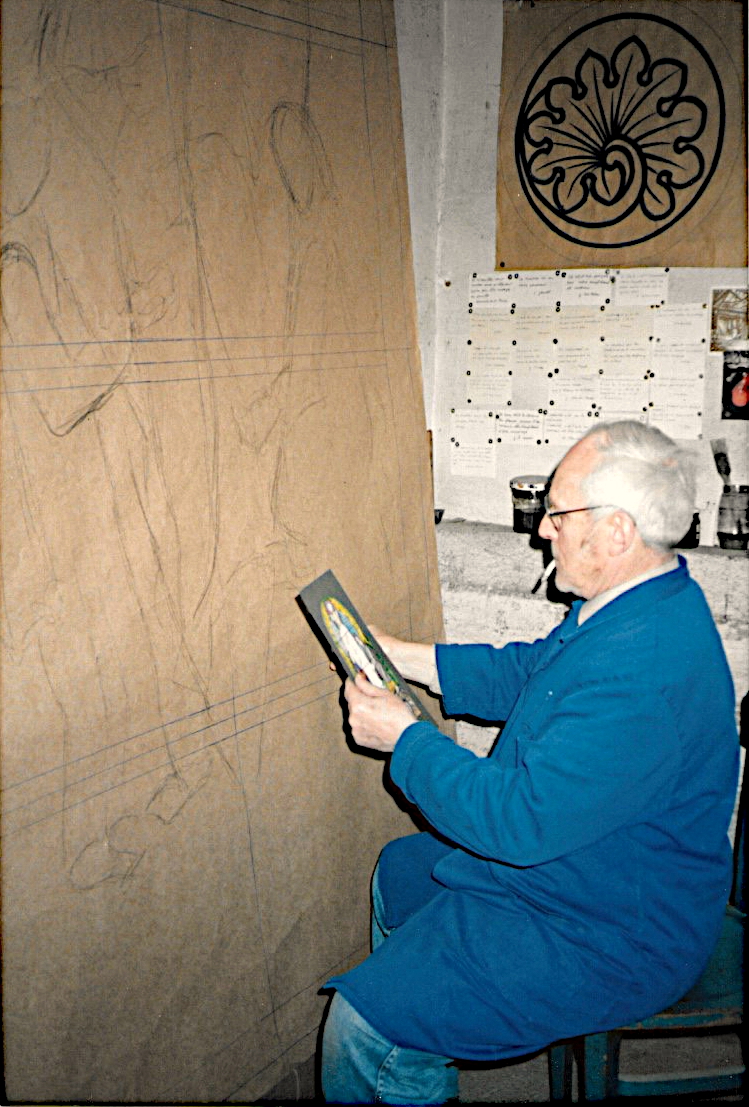
Photo©AssociationCharlesCarrère
Then he makes the equivalent of a “dressmaker’s pattern”, i.e. each piece is reproduced on hard cardboard. Charles Carrère then cut each piece to size: he placed his slab of glass on the edge of the block of wood and, using the hammer, struck the slab of glass until he obtained the desired shape. He used to talk about listening to the note of the glass to grasp the right moment and the right impulse to strike.
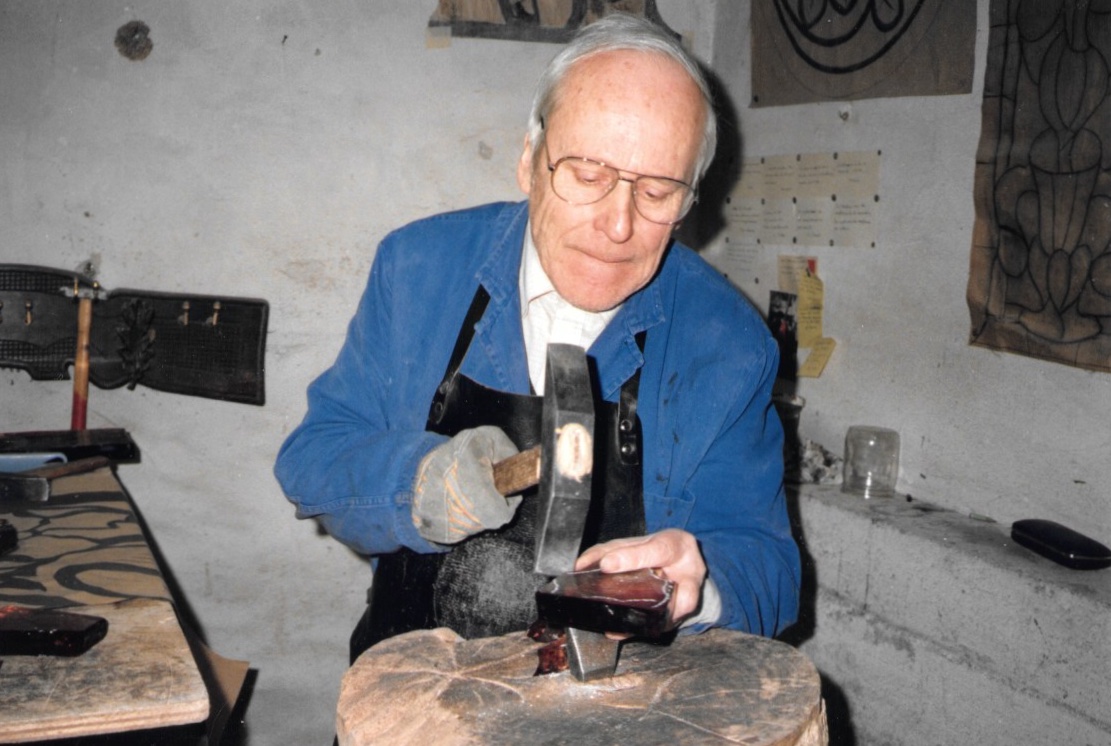
Photo©AssociationCharlesCarrère
Once all the pieces have been cut, he places the slabs on the pouring table. He makes a form to fit the dimensions of each panel and pours the mortar, trowelling in the large joints before finishing with a more liquid mortar.
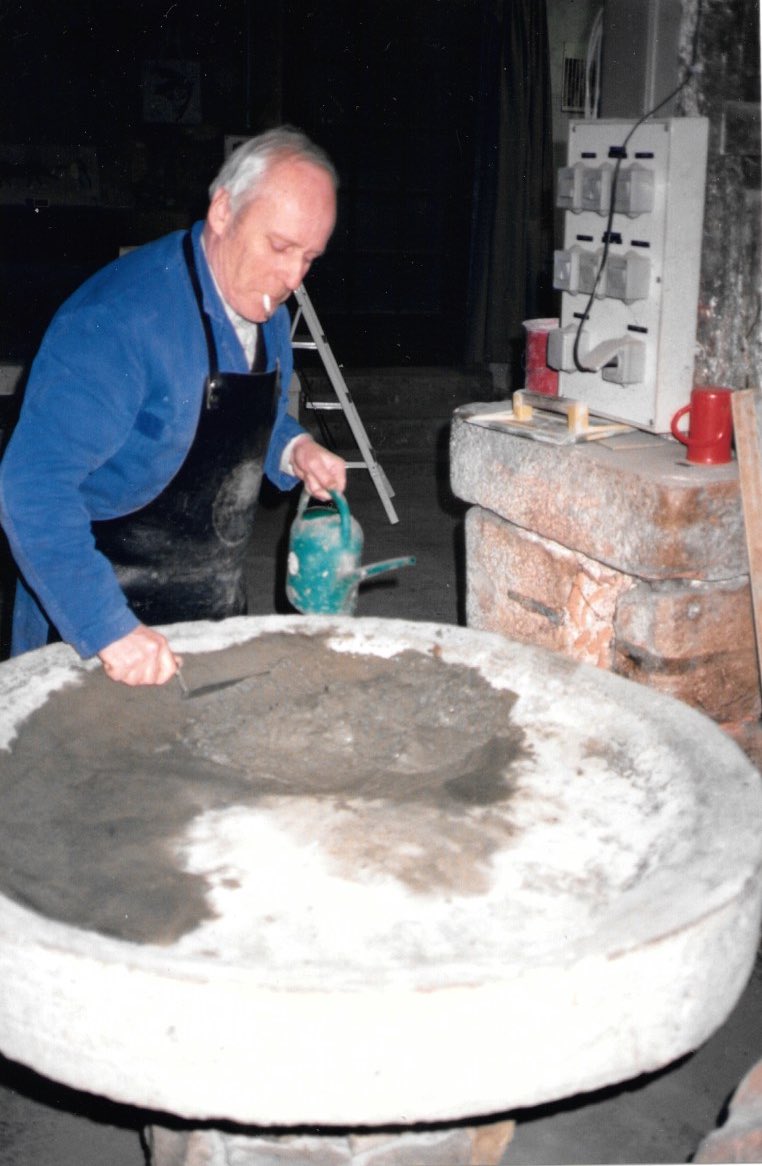
Photo©AssociationCharlesCarrère
The stained glass will then be cleaned to remove any superfluous cement. While waiting for it to dry completely, the Master Glassmaker begins a new sketch for the next work.
Charles Carrère takes steps to ensure his stained glass windows are well protected for the journey when they are delivered.
Fortunately, Bayonne is not far away and the port of Bayonne is home to specialist shipping companies. So the Maître Verrier ordered 6 sturdy sea boxes
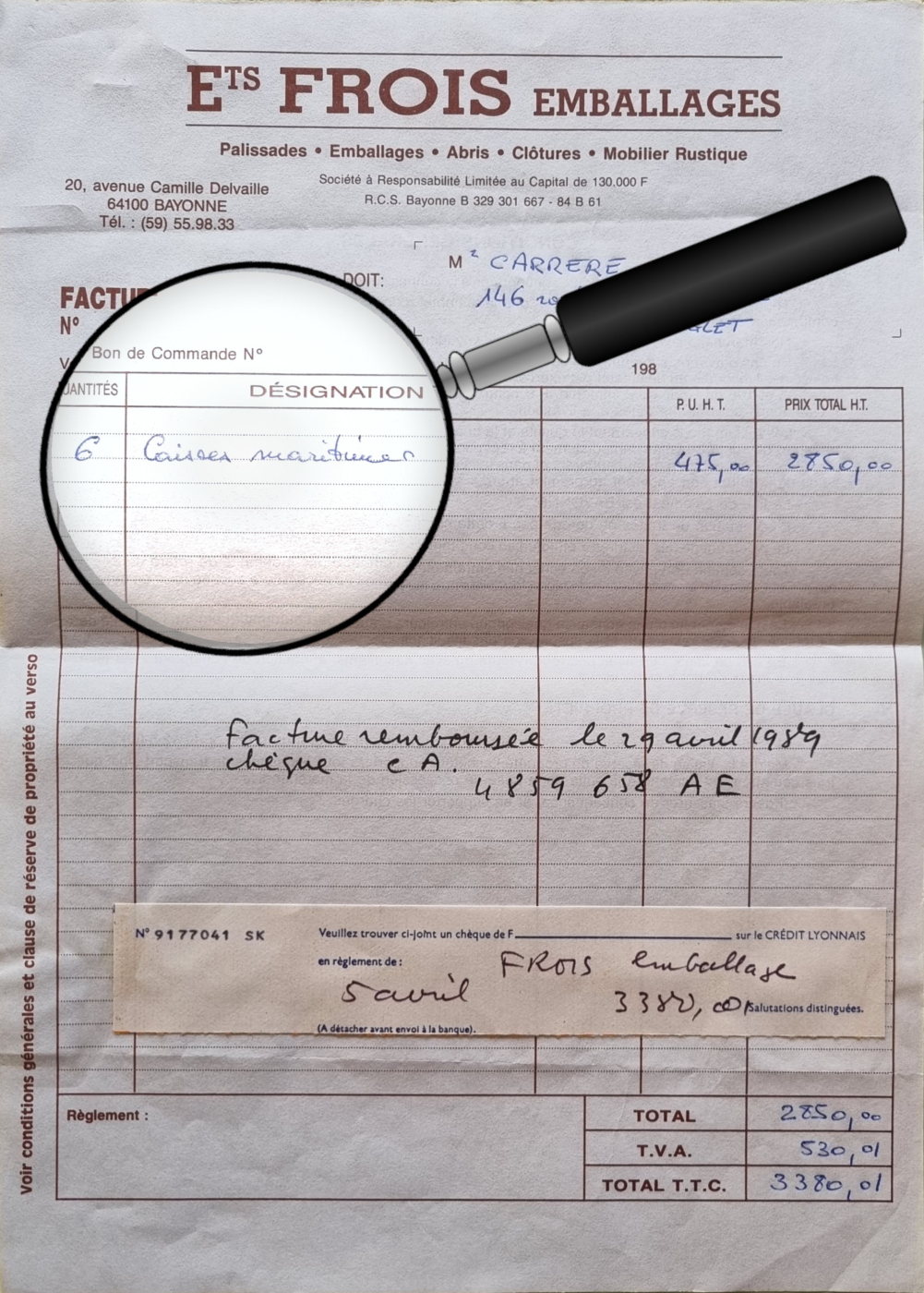
Photo©AssociationCharlesCarrère
The crating of each stained glass panel is a delicate operation. A stained glass panel is not light! Fortunately, Charles Carrère had help with the crating, and the photo gives a good idea of what a stained glass panel looks like before it is installed.
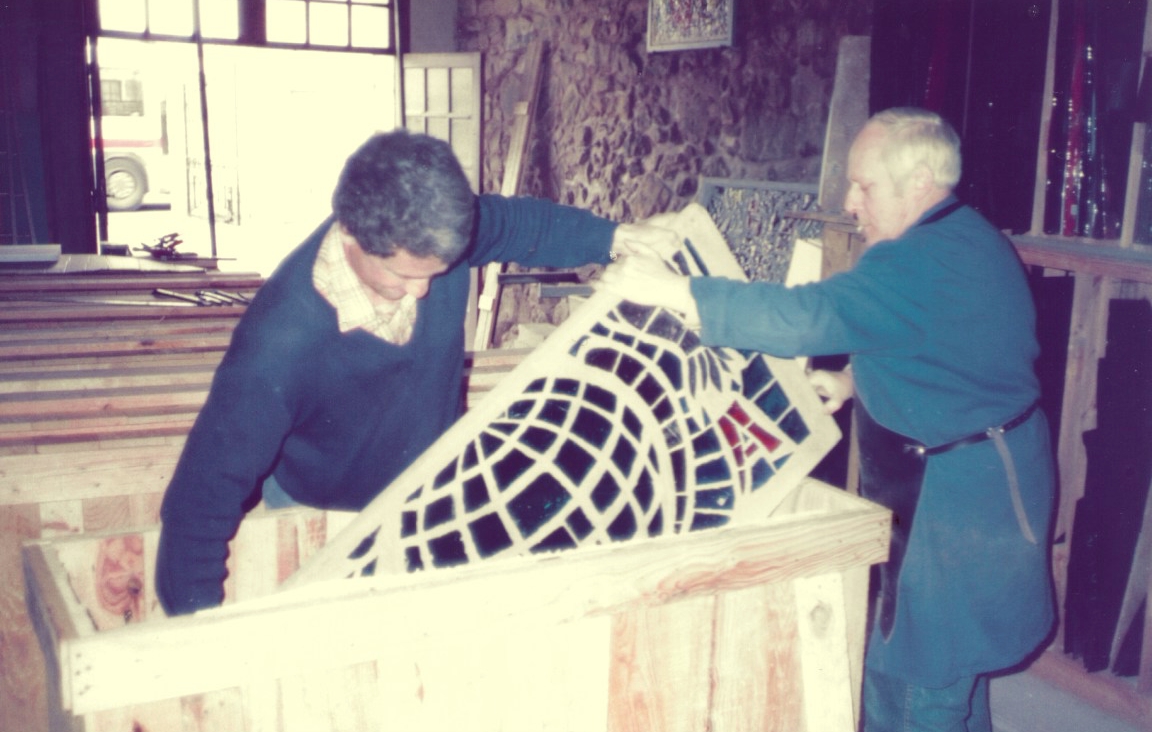
Once the stained glass has been installed in its “case”, it is protected from knocks by a material that resembles straw, and then the box is firmly closed, sometimes even strapped.
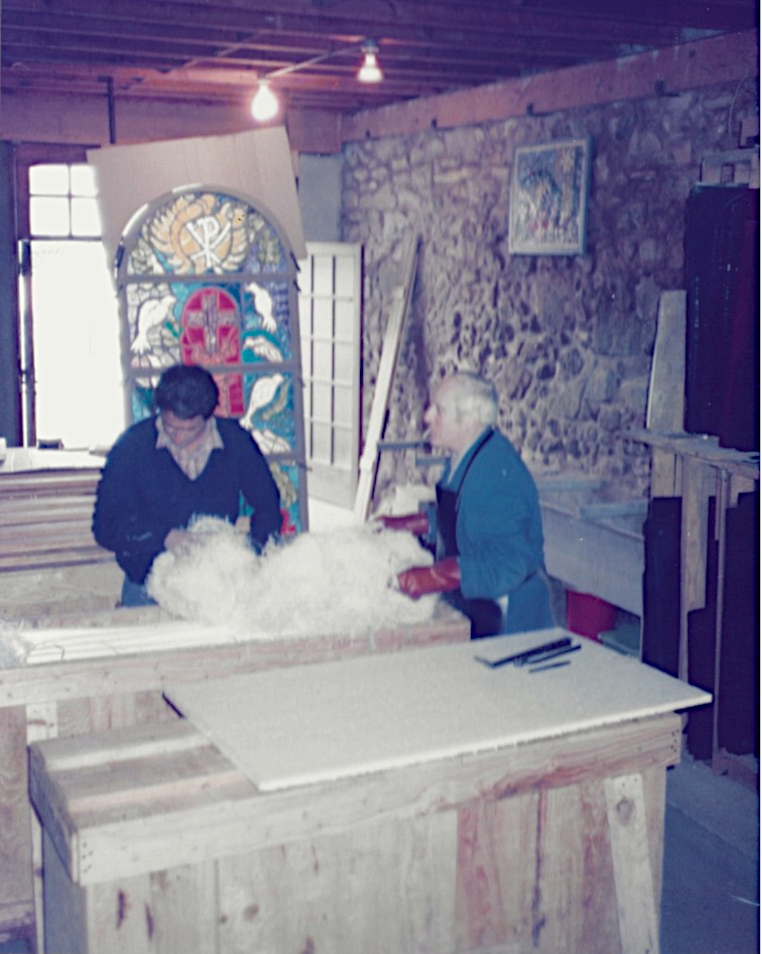
Photo©AssociationCharlesCarrère
The first stained glass windows are ready for the big trip! A carrier from Bayonne will transport the first boxes from Anglet to the port of Rouen.
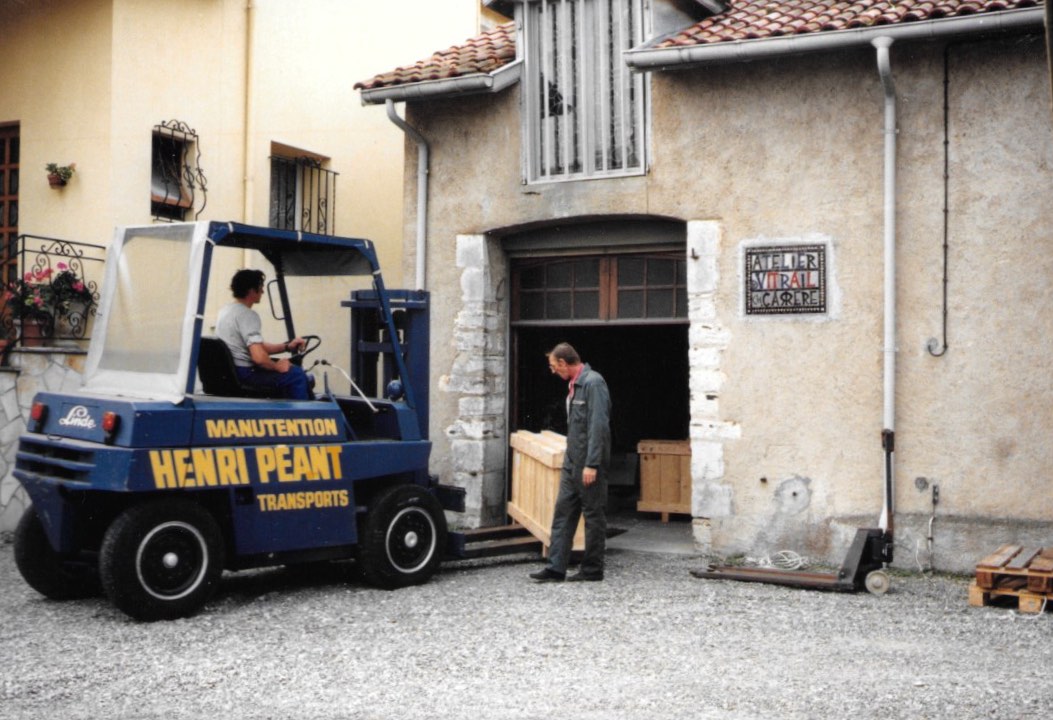
Photo©AssociationCharlesCarrère
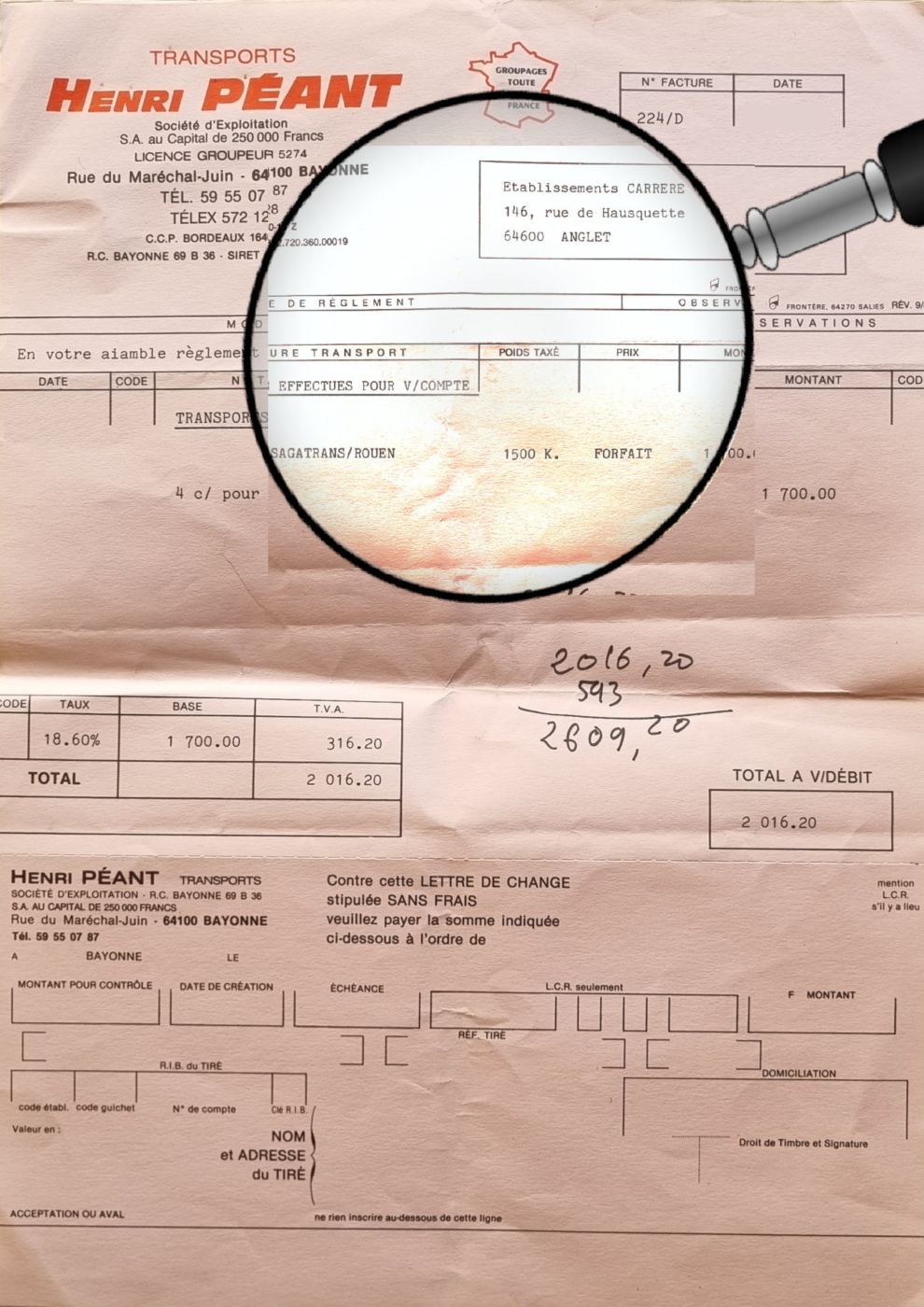
Photo©AssociationCharlesCarrère
The Rouen-based shipping company is loading the crates for Le Havre. The container ship will leave Le Havre for the island of La Réunion in the Indian Ocean.
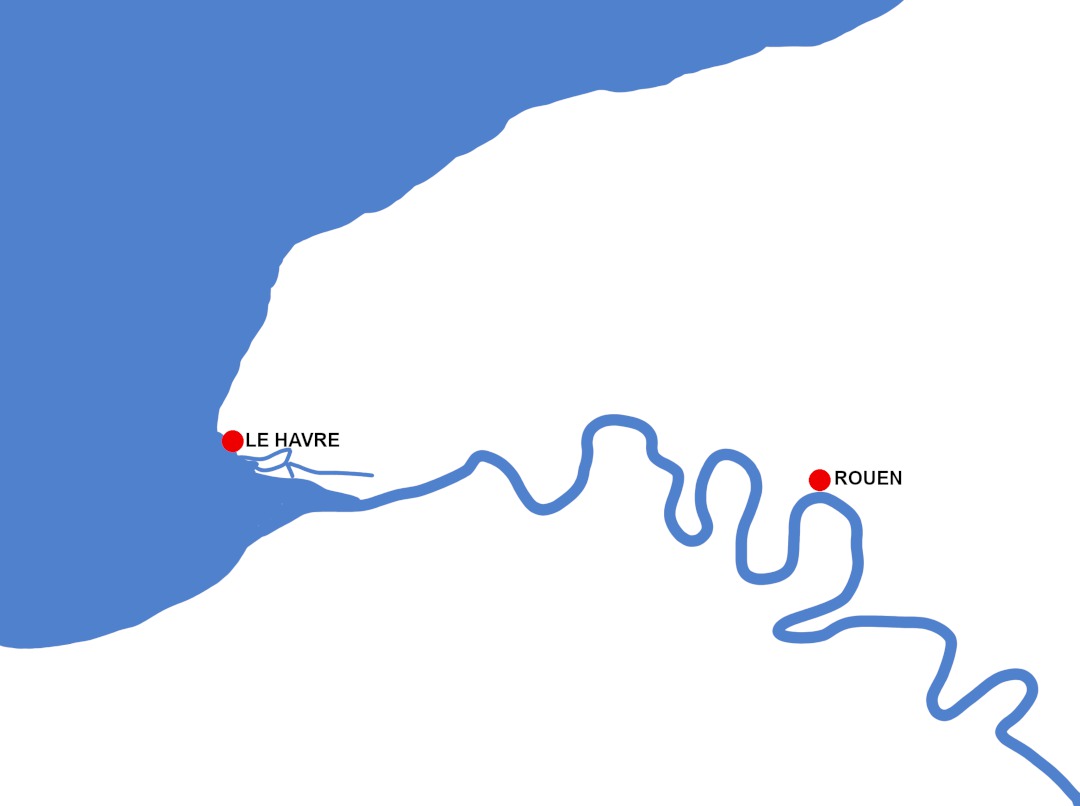
The notice of shipment marks the start of the long journey of the crates containing Charles Carrère’s stained glass windows to Saint-André de La Réunion.

Photo©AssociationCharlesCarrère
As indicated on the notice of shipment, the scheduled departure date is 05/05/1989 and the scheduled arrival date is 26/05/1989. The crates are placed in a container. It was the container ship Rosa M that took on board the precious parcel. Charles Carrère’s stained-glass windows finally sailed for La Réunion!
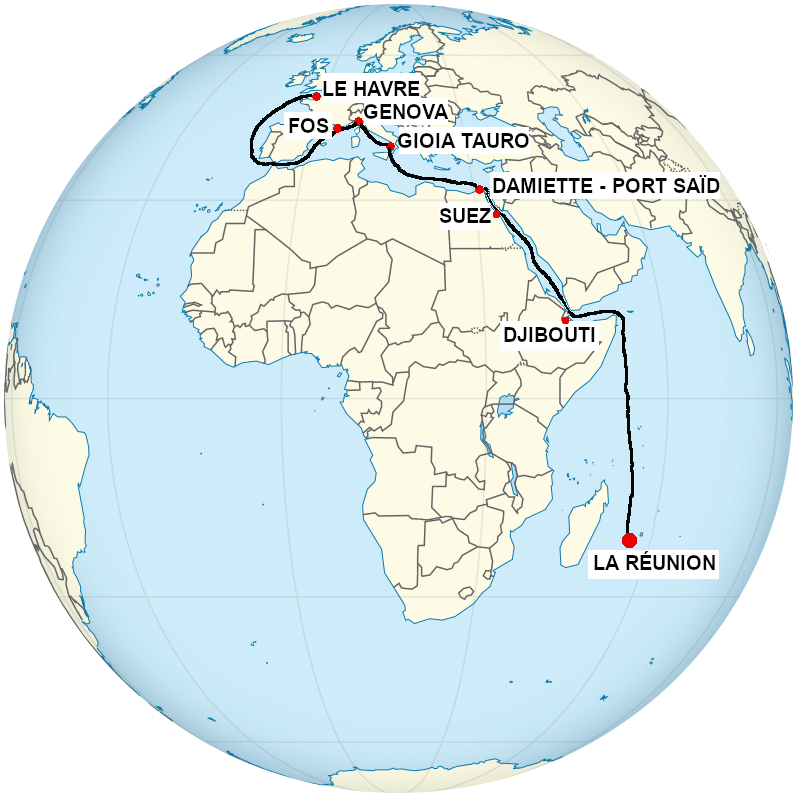
autor M.Bitton
Inserting the boat’s route : ©JanieC
And finally, as planned after a 21-day voyage, the Rosa M arrived at the port of La Pointe des Galets. It is located in the commune of Le Port. Charles Carrère was on hand to immortalise the event.
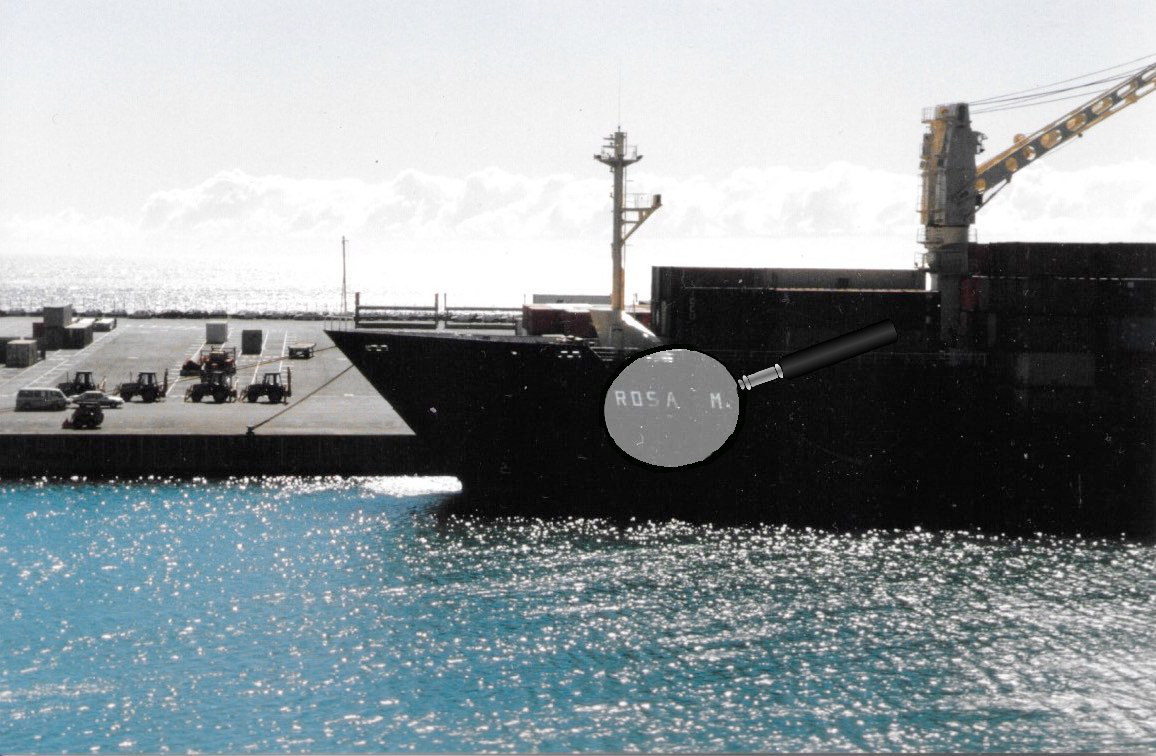
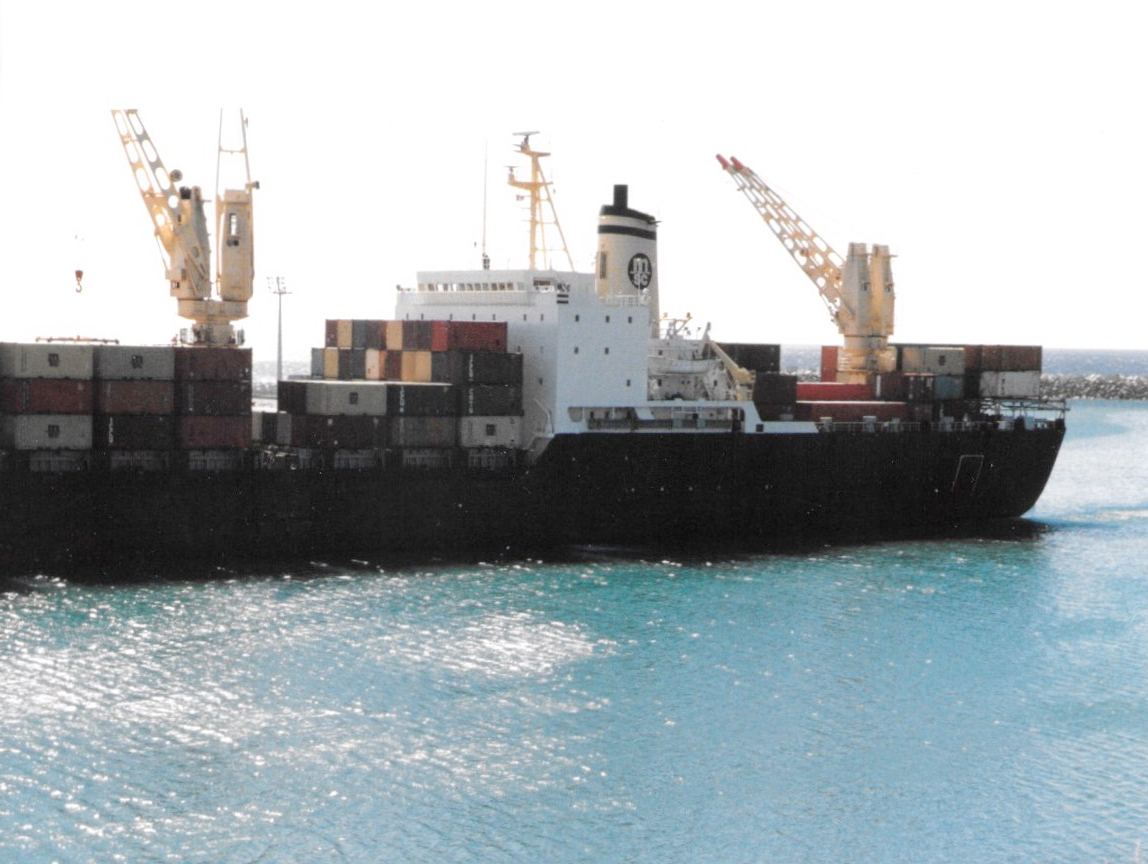
Saint-André church in the commune of Saint-André
Charles Carrère created the name of the church in mosaic on the spot
Then everyone came along to help install the name on the façade. The material is heavy and it’s a delicate operation.

Photo©AssociationCharlesCarrère
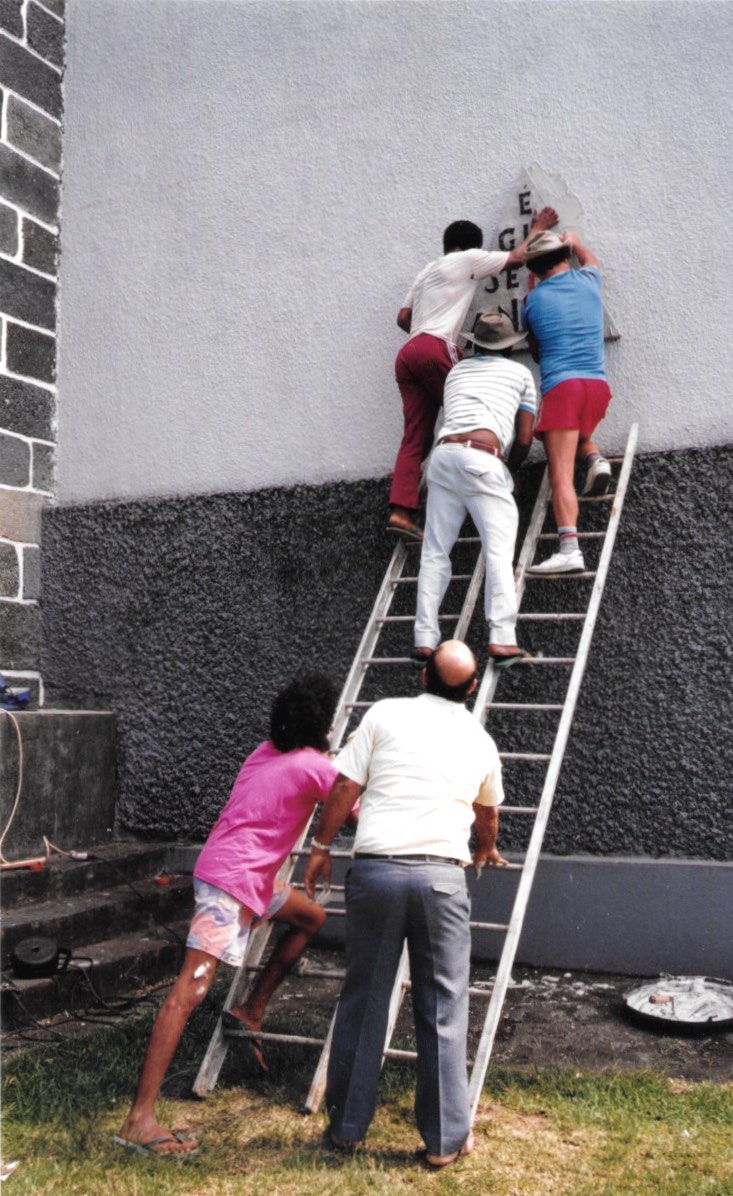
Photo©AssociationCharlesCarrère
Today, the mosaic is still in place on the façade of the church. The mosaic was made using Venetian enamel. Each tessera is hammered and then inserted into the cemented triangle.
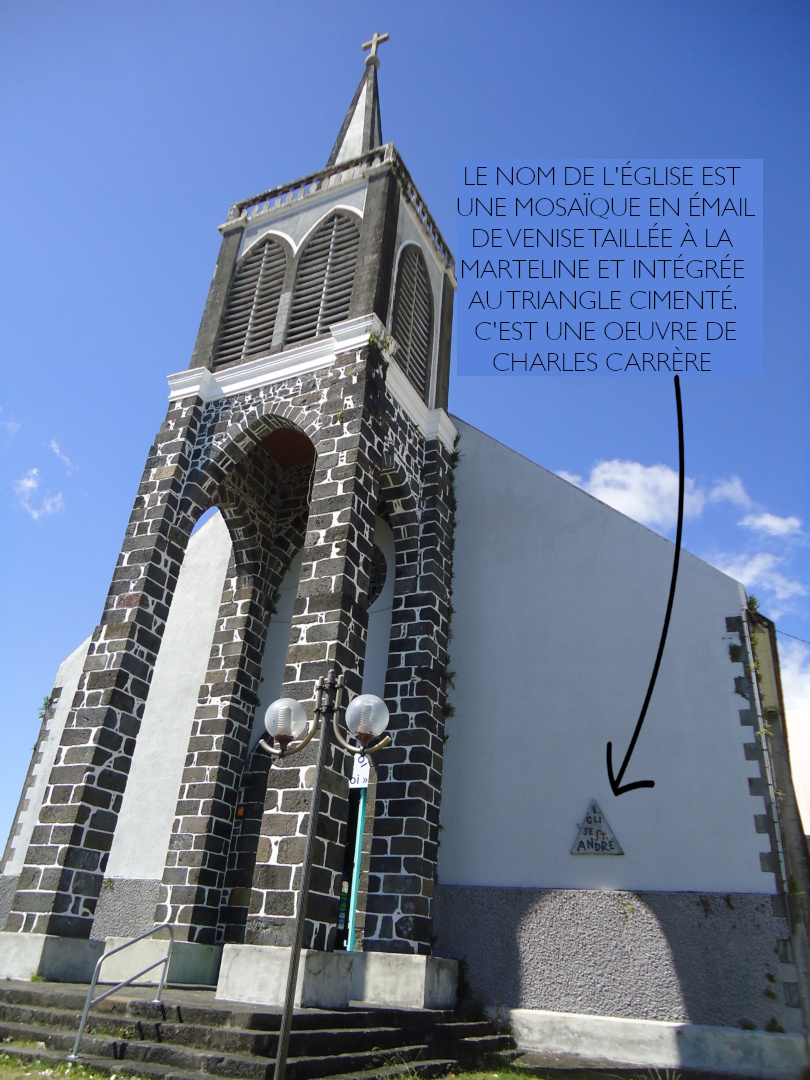
CC BY-SA 4.0 commons.wikimedia.org
Discovery of the 6 stained glass windows
The church is decked out in the colours of stained glass
Stained glass window of Saint-André: the cross of Saint-André: so called because Saint-André was crucified on an X-shaped cross. Each stained glass window tells several stories.
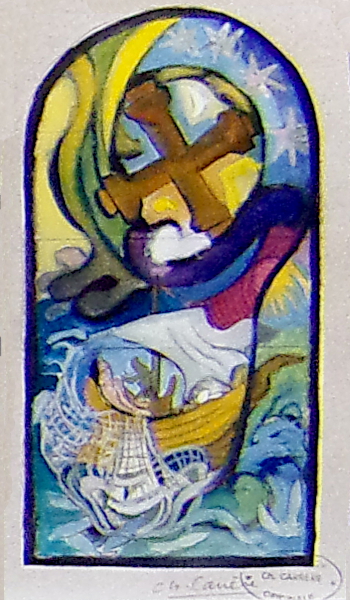
Photo©AssociationCharlesCarrère

He shows us the sky with the stars, the sun and the stars, but also the sea, which seems to be raging. This sea is the Sea of Tiberias, sometimes called the Lake of Gennesaret or the Lake of Galilee, or simply the sea. Charles Carrère depicted the two powerful scenes that took place there: the calmed storm and the miraculous catch.
The Master Glassmaker has depicted Peter’s boat, the symbol of the Church, sailing through the turbulent waters of the world.
The fishing net recalls the kingdom of heaven, and the fish of all kinds caught in the net are the faithful who join the church.
Charles Carrère has discreetly inserted a symbol as a nod to Father Emile and the Basques who pass through the church. At the bottom right is the Basque cross, a symbol of identity that translates as lauburu. (See next small photo)
Photo©JulietteLassalle
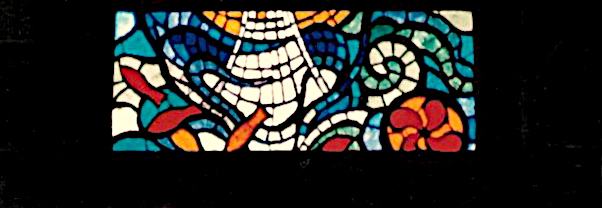
Below right is a detail showing the red Basque cross on a yellow-orange background.
(It is cut off in the large photo above)
Creation stained glass window: The stained glass window reminds us of the story of Genesis.

photo©AssociationCharlesCarrère
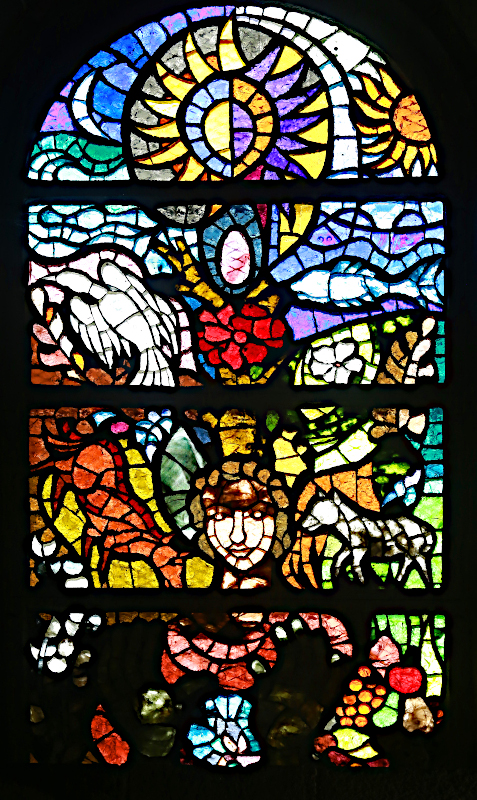
At the top left is night with the moon and at the right is day with the sun. Light comes out of chaos: Genesis (Gn1) God said: “Let there be light”. And there was light. God saw that the light was good and God separated the light from the darkness. God called the light “day” and the darkness “night”. There was evening and there was morning: that was the first day”.
The large central sun positioned in a sort of mandorla is also divided into a dark and a light part, recalling morning and evening, light and darkness.
The central tree with its branches and leaves represents the plant world of creation.
In the lower left-hand corner, Charles Carrère has depicted a wild animal facing a domestic animal. Fruit and herbs complete the symbolism of the plant world.
And at the very bottom are 2 hands: those of God, who kneads man from the clay of the earth and creates him in his own image.
Thanks to Frédéric BAMBA for sending this photograph.
Photo©FrédéricBAMBA
Stained glass window of the Nativity: The joyful mystery of the coming of the Child Saviour: Jesus Christ.
As always, the master stained-glass artist produced a sketch and then a colour model of the future stained-glass window.
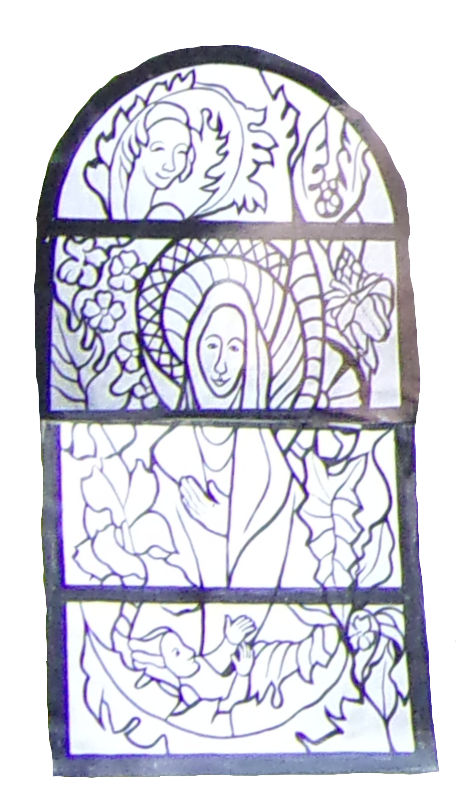
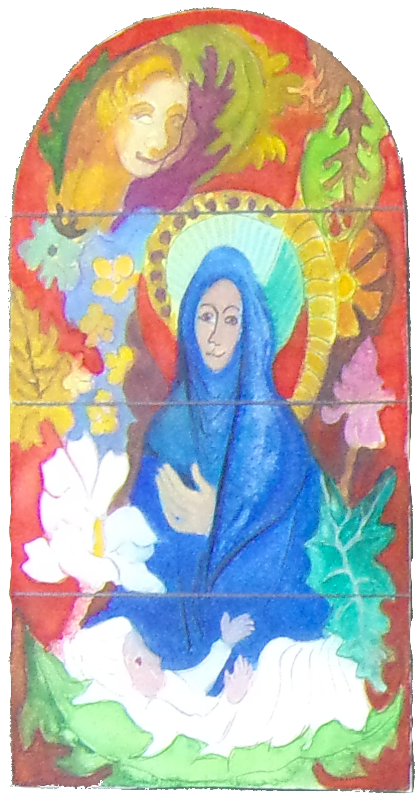
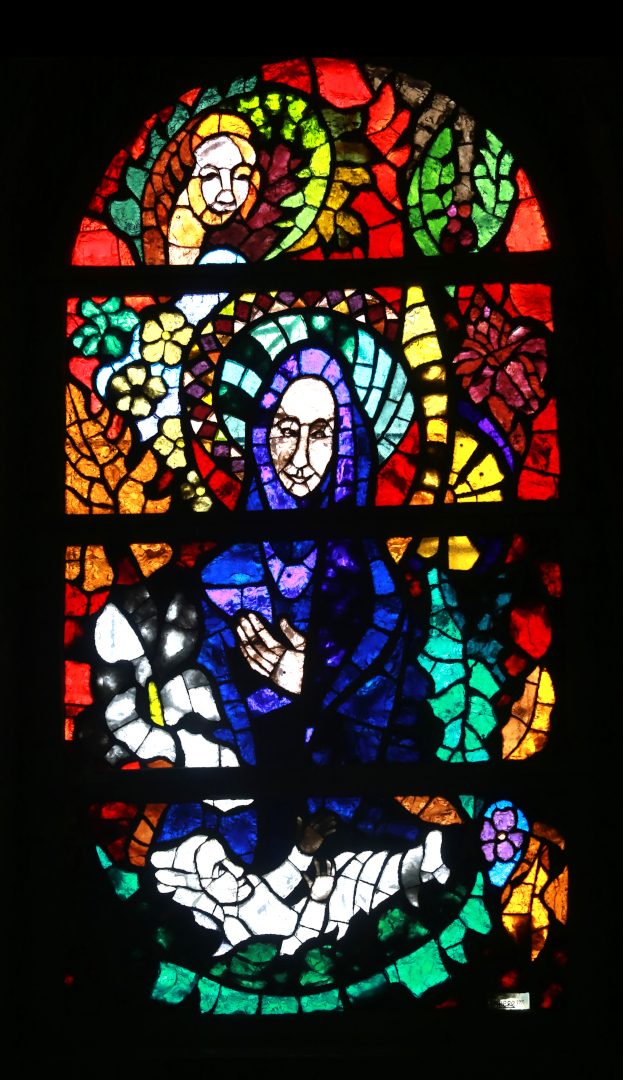
For stained glass window about Nativity , Charles Carrère chose to illustrate it in two stages.
First step
This is the joyful mystery, the Annunciation. In the top left-hand corner, the Angel announces to the Virgin that the Holy Spirit will come to overshadow her and that she will give birth to a son.
The son is in this lily, which symbolises the last flower on the last stalk of Jesse’s tree. The tree of Jesse is the schematisation of the genealogy of Jesus, that is to say his family tree starting from Jesse, father of King David.
Second step
This is the glorious mystery. The Virgin is with the Child Jesus. She is seated on the tree of Jesse, the greenery of which can be seen. The Virgin Mary is in the enclosed garden of the Song of Songs. The red background reminds us that Christ was born to sacrifice himself and offer his blood to save humanity from sin.
Photo©AssociationCharlesCarrere
Stained glass window of the Virgin Mary : Charles Carrère chose to depict her in glory in a mandorla.
The stained glass window has been slightly modified compared to the sketch: the boat has been removed in favour of the crowned letter M and the vase on the right features a lily. The open hands have been removed. The predominant colour is blue, the colour of the Virgin Mary.
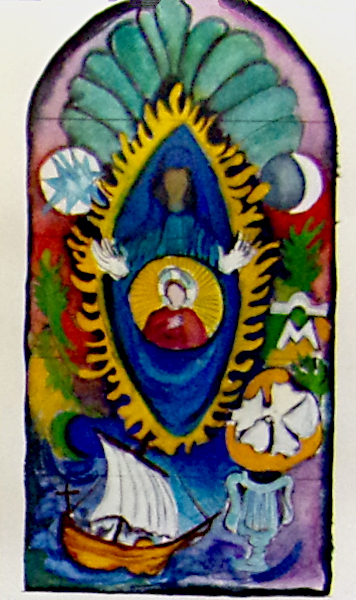
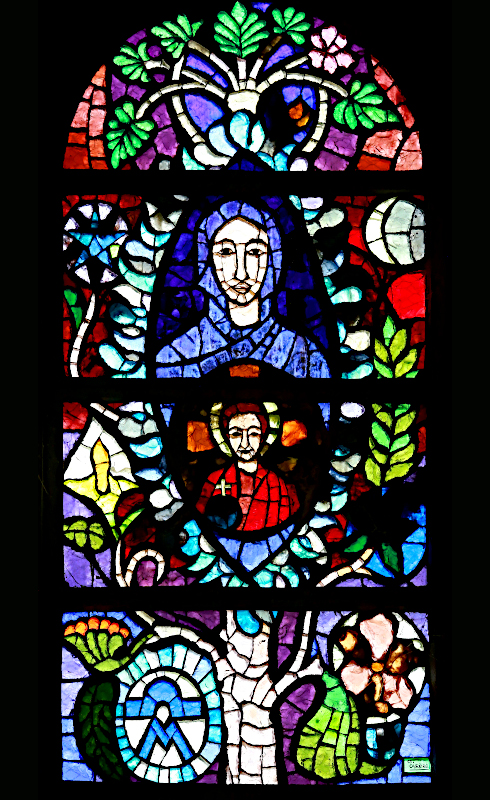
The Virgin Mary wears a medallion on her chest. It depicts the infant Jesus, as in the ancient Greek medallions of the Eastern Orthodox Church.
On either side of the Virgin we have the moon on the right and the star on the left, the morning star found in Revelation 22:16: Christ defines himself “I, Jesus, have sent my angel to testify these things to you in the churches. I am the offspring and the seed of David, the bright morning star.” And with this morning star “Stella Matutina”, the Master Glassmaker also left the idea of the symbol of the Virgin Mary.
In the bottom right-hand corner is a green vase with a flower. This is the vase of election, another symbol of the Virgin who gave birth to Jesus. In the vase, a white flower is the lily of the valleys as defined in the Song of Songs: “I am the rose of the Sarone, the lily of the valleys…”. Ct 2,1.
On the left, facing the vase and in a circle, the crowned letter M. This recalls the Litany of the Virgin: “…Queen of angels, patriarchs and prophets…”.
Finally, at the bottom centre of the window, we can see the trunk of Jesse’s tree, whose foliage rises above the mandorla. The tree of Jesse is the symbol of Jesus’ genealogy.
Thanks to Frédéric BAMBA for sending this photograph.
Photo©FrédéricBAMBA
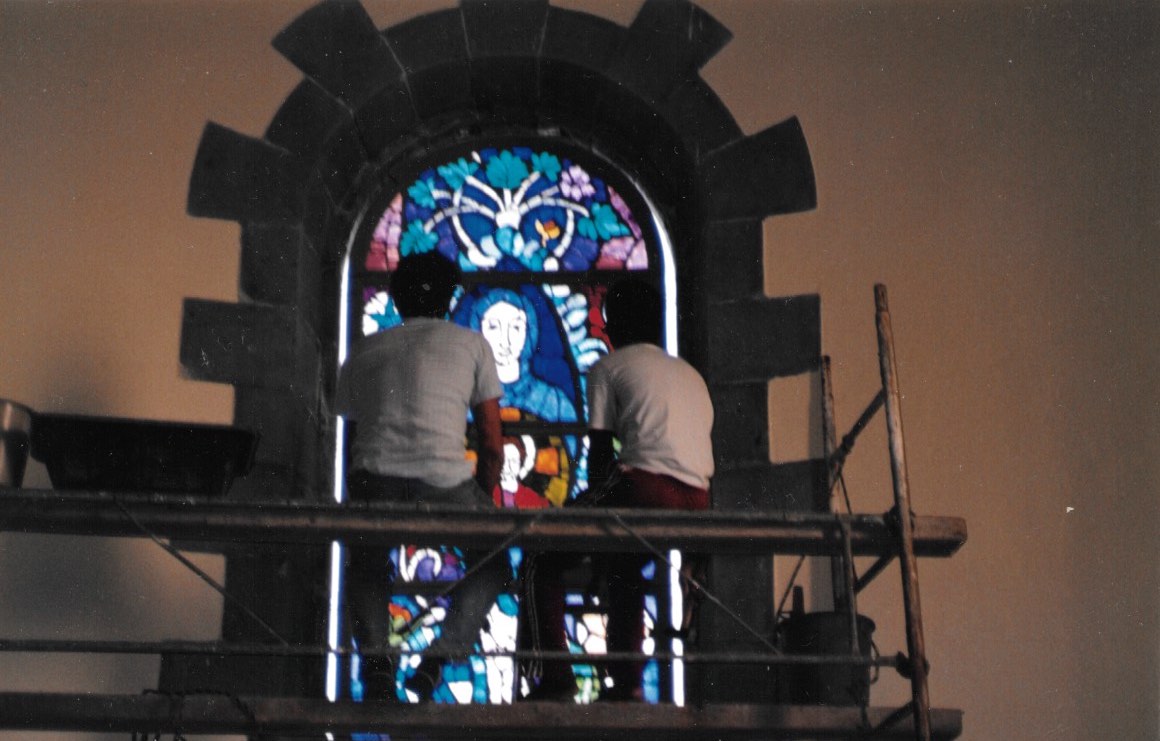
Photo©AssociationCharlesCarrère
The stained glass window of the Cross of Life: Charles Carrère drew his inspiration for this stained glass window from liturgical hymns.
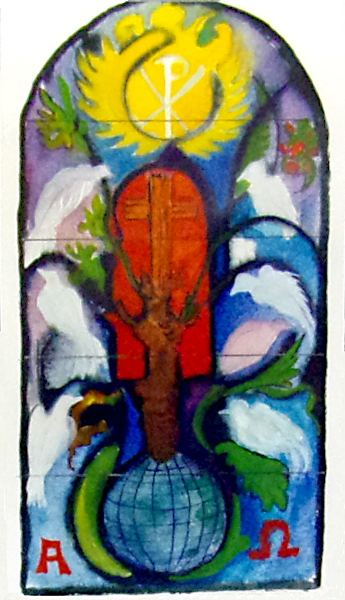
Photo©AssociationCharlesCarrère
The inspiration is drawn from the songs of Good Friday:
“O cross set up over the world, O cross of Jesus Christ, River whose fruitful water has gushed forth from an open heart, through You life overflows, O cross of Jesus Christ“.
The Master Glassmaker has depicted a tree on the globe from which emerges the wooden cross, the wood of the Good Friday cross. The background is red, reminiscent of the Passion.
On the branches of the tree, seven birds represent the 7 gifts of the Holy Spirit: Wisdom – Intelligence – Advice – Strength – Science – Piety – Fear of God (not in the sense of fear but in the sense that we must remain humble)
At the top, in white against a yellow background (in the light), is the Chrism, the seal of Christ. The Chrism is the monogram of Christ made up of the first two Greek letters of his name, i.e. X (Khi) and P (rho).
Et enfin tout en bas à gauche la lettre Alpha et à droite la lettre Oméga en référence à Apocalypse 22 – 13 “Je suis l’alpha et l’oméga, le premier et le dernier, le commencement et la fin.”
Photo©JulietteLassalle

Nuit Pascale stained glass window: Nuit Pascale is also known as Vigile Pascale or Veillée Pascale.
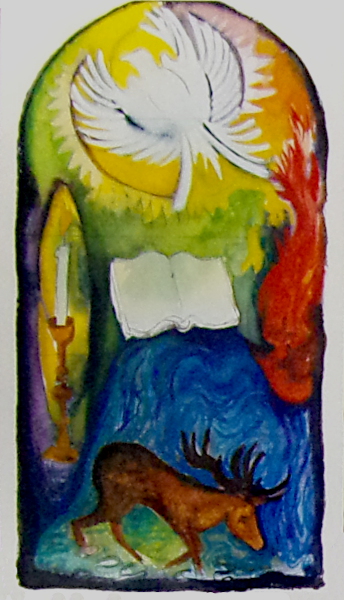
Photo©AssociationCharlesCarrère
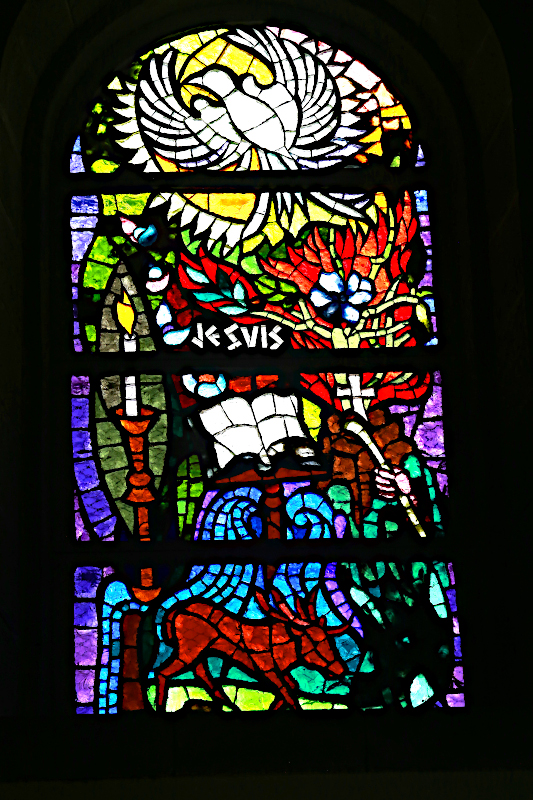
In the centre of the stained glass window, Charles Carrère has placed the lectern on which “The Book”, the source of life, symbolises the Bible. During the Paschal Night, the readings retrace the major stages of God’s Covenant with mankind.
Just above the Bible, “I am” and to the right, the flames of a fire in reference to the burning bush where God spoke his name to Moses, “I am he who is” (or I am he who is).
Behind the foot of the lectern we see water and on the right, a hand holding a stick and striking the rock. Reference: Exodus 17:6 “I will stand before you on the rock in Horeb. You will strike the rock, and water will come out of it, and the people will drink. This is what Moses did in the eyes of the elders of Israel”.
There is a cross on the rock, because Charles Carrère is showing that the rock prefigures Christ.
At the very top of the stained glass window, in a glory of light, is the bird symbolising the Holy Spirit.
Finally, at the very bottom, a stag is drinking, as quoted in Psalm 42: “As a stag yearns for streams, so my soul yearns for you, O God”. The stag drinking can be understood, says the Master Glassmaker, as the motivation of the faithful who wish to be baptised.
Photo©FrédéricBAMBA
Window with flowered rosette
For this decorative rosette, Charles Carrère chose to illustrate it with an explosion of flowers, fruit and colours as found on Reunion Island.
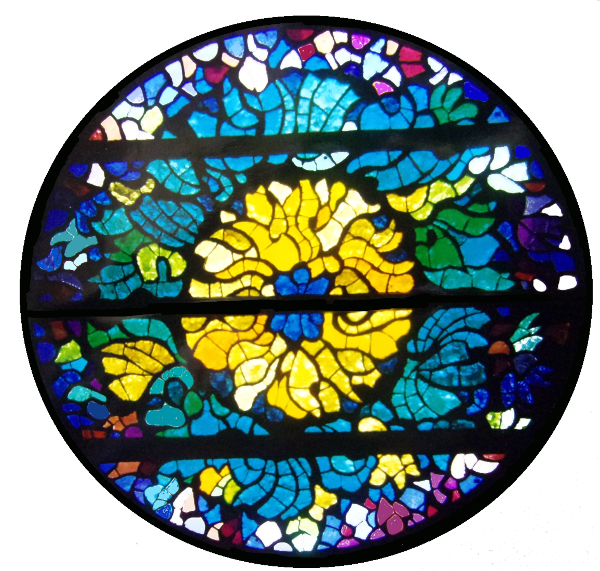
The Eucharist stained glass window : the Eucharist comes before communion.
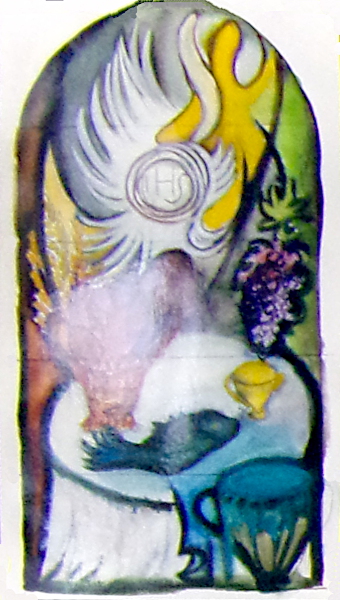
©AssociationCharlesCarrère
To illustrate the Eucharist, Charles Carrère depicted the table set and, in the lower right-hand corner, the overflowing cup from Psalm 23: “You prepare a table before me in the presence of my adversaries; you anoint my head, my cup overflows” (v. 5). In this way, the Master Glassmaker expresses the Lord’s hospitality towards human beings.
On the table, we see the fish, which is red because in Reunion Island the fish “Le Rouge” is highly prized. Then there is the basket of bread, symbolising the miracle of the multiplication of the loaves, the nourishment of the body.
The wheat, the bunch of grapes and the cup represent the sacrament of the Eucharist.
At the top, the Host in glory and the IHS representing the monogram of Christ.
Photo©FrédéricBAMBA
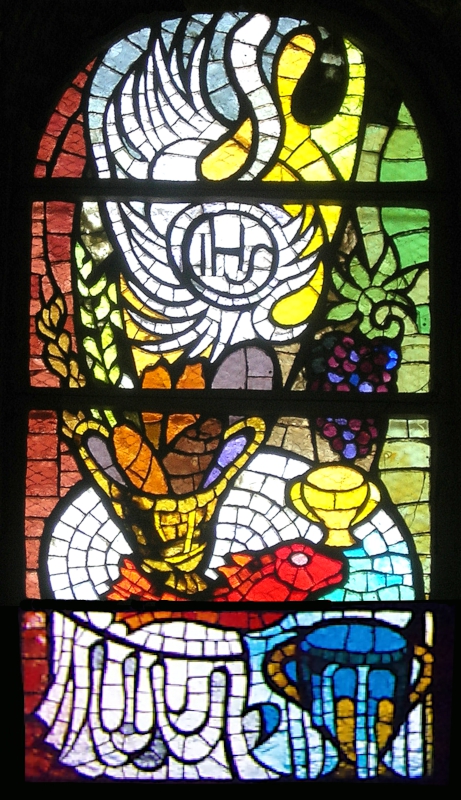
Vine stained glass window : at the Eucharist, the priest blesses the wine that represents the blood shed by Christ
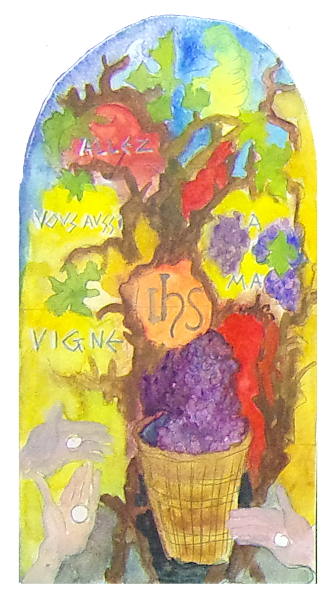
©AssociationCharlesCarrère
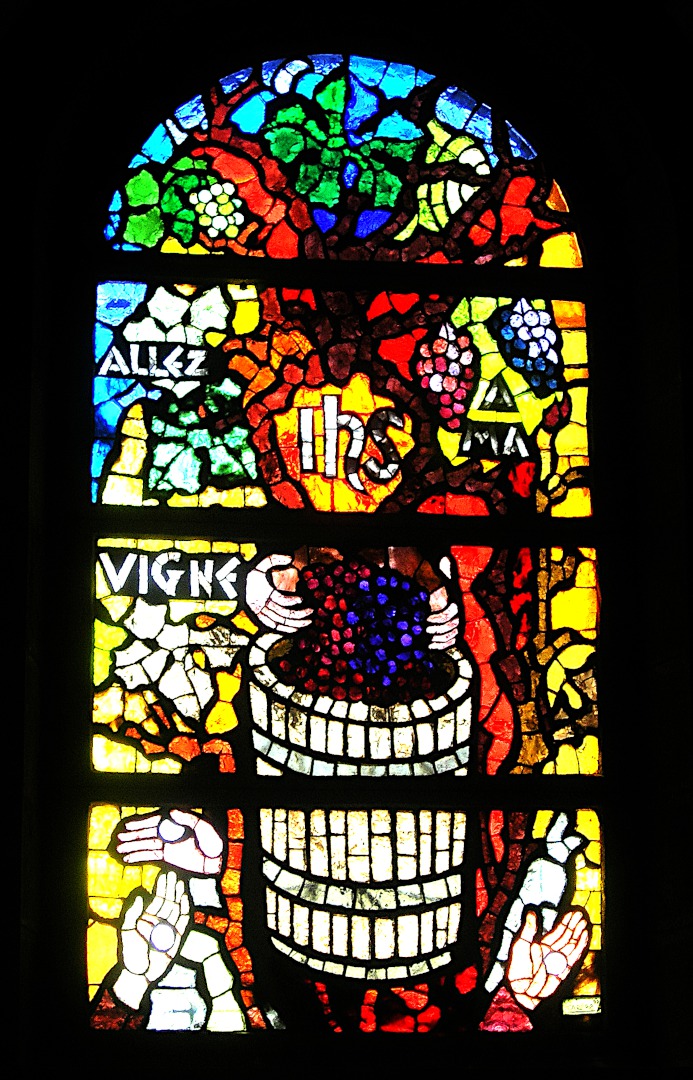
Charles Carrère developed the theme of the vine. This theme is dealt with in John 15.5 “I am the vine and you are the branches….”. But in this stained glass window, the Master Glassmaker wanted to recall the parable in Matthew 20.1-16 where the workers in the vineyard receive the same pay for different working hours.
Charles Carrère therefore illustrated the vine with its leaves and bunches of grapes. With the inscription “Go to my vineyard”, again in reference to Matthew. In the middle, as if bathed in light, the letters IHS Christogramme or abbreviation of the name of Jesus Christ in Greek, but it can also be translated into Latin as Iesus Hominum Salvator: Jesus the Saviour of mankind. That’s why the red of the blood he shed to save mankind surrounds his name against a background of light. We can see two hands pouring the grapes into the press, and if we look closely we can see the hands at the bottom each receiving 1 denarius, as explained in the parable in Matthew 20.1.16.
Photo©FrédéricBAMBA
Baptism of Christ stained glass window:
Charles Carrère was inspired to create this stained glass window by the baptism of Jesus in Matthew 3, 13-17.
“Then Jesus came from Galilee to the Jordan. Jesus was baptised by John the Baptist.
As soon as he was baptised, “Behold, the heavens opened and he saw the Spirit of God descending like a dove and coming upon him”.
As for the hand at the top left, the Master Glassmaker has illustrated God’s hand pointing to Jesus: “This is my beloved Son, in whom I am well pleased (or in whom I have placed all my love – depending on the translation)”.
Photo©FrédéricBAMBA
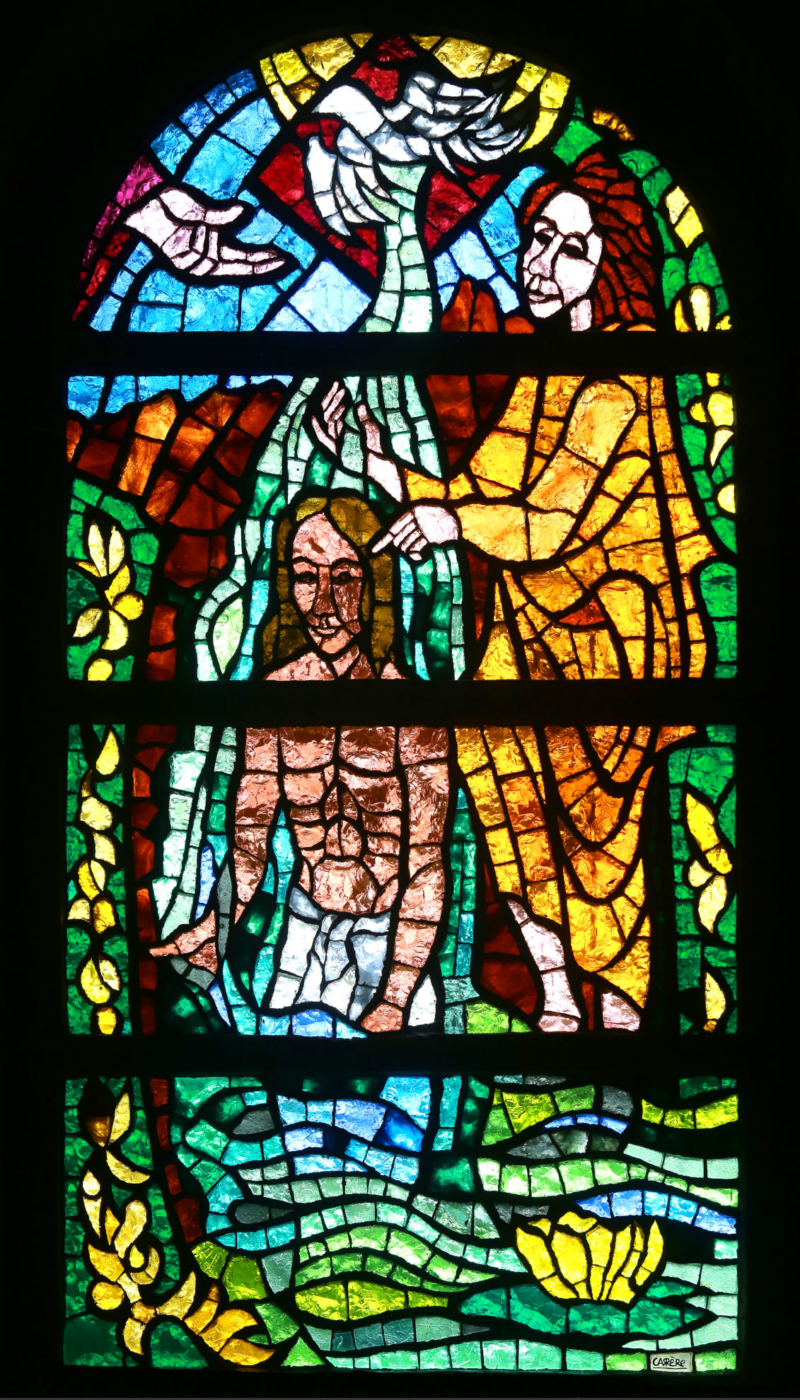
Stained glass window The entry into the heavenly Jerusalem
This stained glass window is 5 metres high and, as with the others, Charles Carrère created not only the colour model but also the execution card, which enables each piece of glass to be placed where it should be.
In the colour model, Christ is not wearing a red robe, but a white cloth tied around his waist.
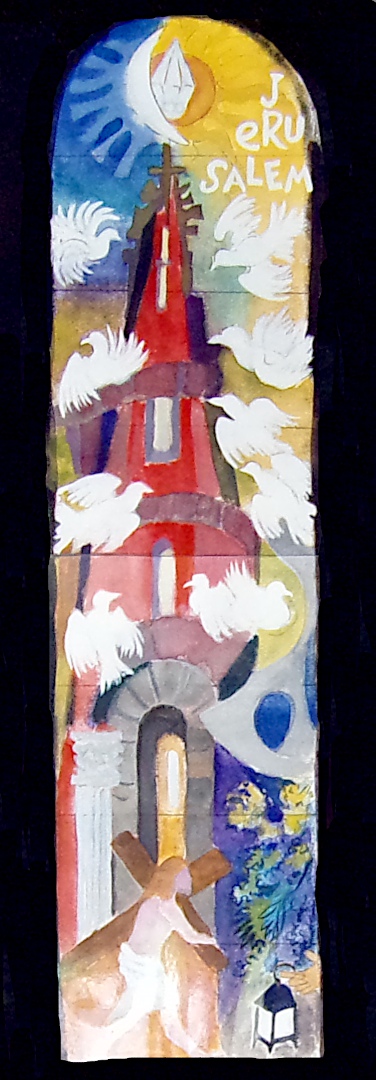

The installation of this large stained glass window is the result of great teamwork. The photo below bears witness to this.

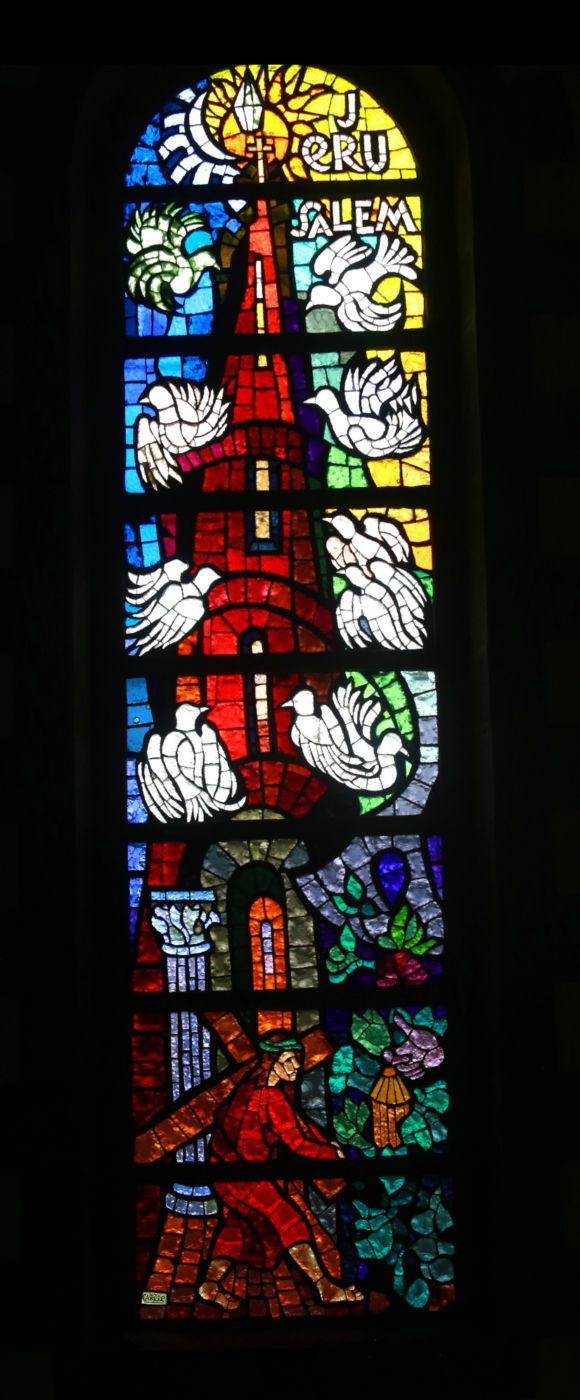
The scene depicted in this stained glass window begins at the bottom. Christ is carrying his cross. Facing Christ, the foliage symbolises the olive trees and a hand holds a lantern: John 18 1-12 : ” ….and guards detached by the chief priests…come there with lanterns…”
Charles Carrère illustrates the heavenly Jerusalem as a kind of tower with narrow gates: Matthew 7:13 “Enter by the narrow gate” – this narrow gate is the only one that leads to heavenly glory, unlike the wide-open, easy-access gate that leads only to perdition.
On each side the doves symbolise the souls that Christ takes with him Isaiah 60:8 “All peoples will come to you as doves come to the dovecote”.
Above, the moon and the sun: Isaiah 60:19 “You will no longer need the sun as a light by day and the brightness of the moon by night, for the light of God will be sufficient for you”.
And in front of the sun, Charles Carrère has inserted a stone cut like a diamond – Revelation 21:11: “The heavenly Jerusalem has the glory of God within her. It shines like a most precious stone, like a crystalline jasper stone”.
Photo©FrédéricBAMBA
Rosace Jésus-Christ
Charles Carrère drew his inspiration for this rose window from Philippians 2: 9-10, “For this reason God also has highly exalted him and given him the name that is above every name, so that at the name of Jesus every knee should bow in heaven and on earth and under the earth”.
The master glassmaker offers a kind of explosion with light, stars, water, plants and the love of Christ symbolised by a heart. Charles Carrère places the name Jesus Christ at the centre of time and the universe, delimited in the rose window by the 4 cardinal points: North East South West and to clearly mark the top and bottom he has placed at the top the letter Z for Zenith and at the bottom the letter N for Nadir, the Nadir meaning the lowest point.
Photo©FrédéricBAMBA
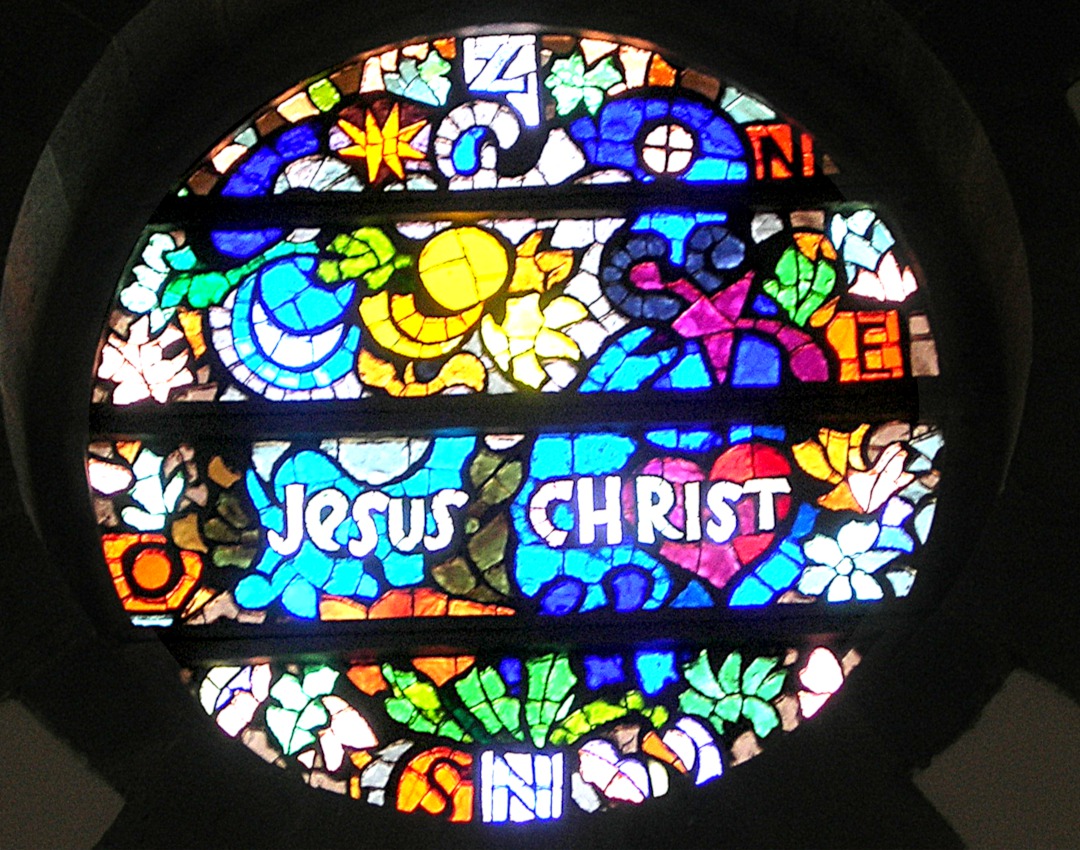
The passion of Christ stained glass window
This is the second stained glass window, measuring 5 metres in height. The colour model is quite different from the final version. In the stained glass version, the Master Glassmaker chose to write the names of the main characters in the story of the Passion.


In this stained glass window, Charles Carrère recalls the story of the Passion. Christ is in the centre in red, the colour of the blood shed. He wears a crown of thorns and a purple cloak. John 19: “… The soldiers, weaving a crown of thorns, put it on his head and clothed him in a purple robe”.
Behind Jesus are his loved ones. At the top left, alone at the foot of the cross, is Mary Magdalene. Next: John 19-25: “Now standing by the cross of Jesus were his mother and his mother’s sister and Mary Magdalene.”
There are three crosses at the top of the Calvary: the cross of Jesus, the cross of the good thief and the cross of the bad thief.
Above, the dark sun, the red sun, echoing the blood of Christ: Luke 23-45: “The sun was darkened and the veil of the temple was torn in the middle. Jesus cried out in a loud voice, “Father, into your hands I commend my spirit. When he had said these words, he breathed his last.
This is followed by the various actors in the Passion, with the illustration of the Passion flower in the centre. On the left: Judas, the man who kisses Christ to show the Romans the man to be arrested. Below, the apostle Peter, whom Charles Carrère depicted weeping while hiding his face to remind us that he had denied Christ three times. Below, Barabbas, the criminal who was released instead of Christ. At the bottom, Satan in blue because he is cold.
Right-hand side: Centurion, the man who pierced Christ’s side with his spear (John 19-34). Below: Pilate, the Roman prefect who delivered Jesus to the crowd. Then Caiaphas, the high priest before whom Jesus appears. And finally Herod is also in blue because, says the Master Glassmaker, like Satan, he embodies coldness.
Photo©FrédéricBAMBA
The Transfiguration of Jesus stained glass window
This stained-glass window recalls Matthew 17, when Jesus takes Peter, James and John with him to a remote spot on a high mountain. There he changed his physical appearance, revealing his divine nature to them.
Charles Carrère depicted Christ between Moses and Elijah, with the three apostles Peter, James and John at Christ’s feet, frightened and then reassured.
Matthew 17: “….And he was transfigured before them; his face shone like the sun and his clothes became white as light… and behold, there appeared to them Moses and Elijah talking with him… The disciples fell on their faces in fear. But Jesus drew near and said to them, “Get up, don’t be afraid.” They looked up and saw no one but him, Jesus, alone.
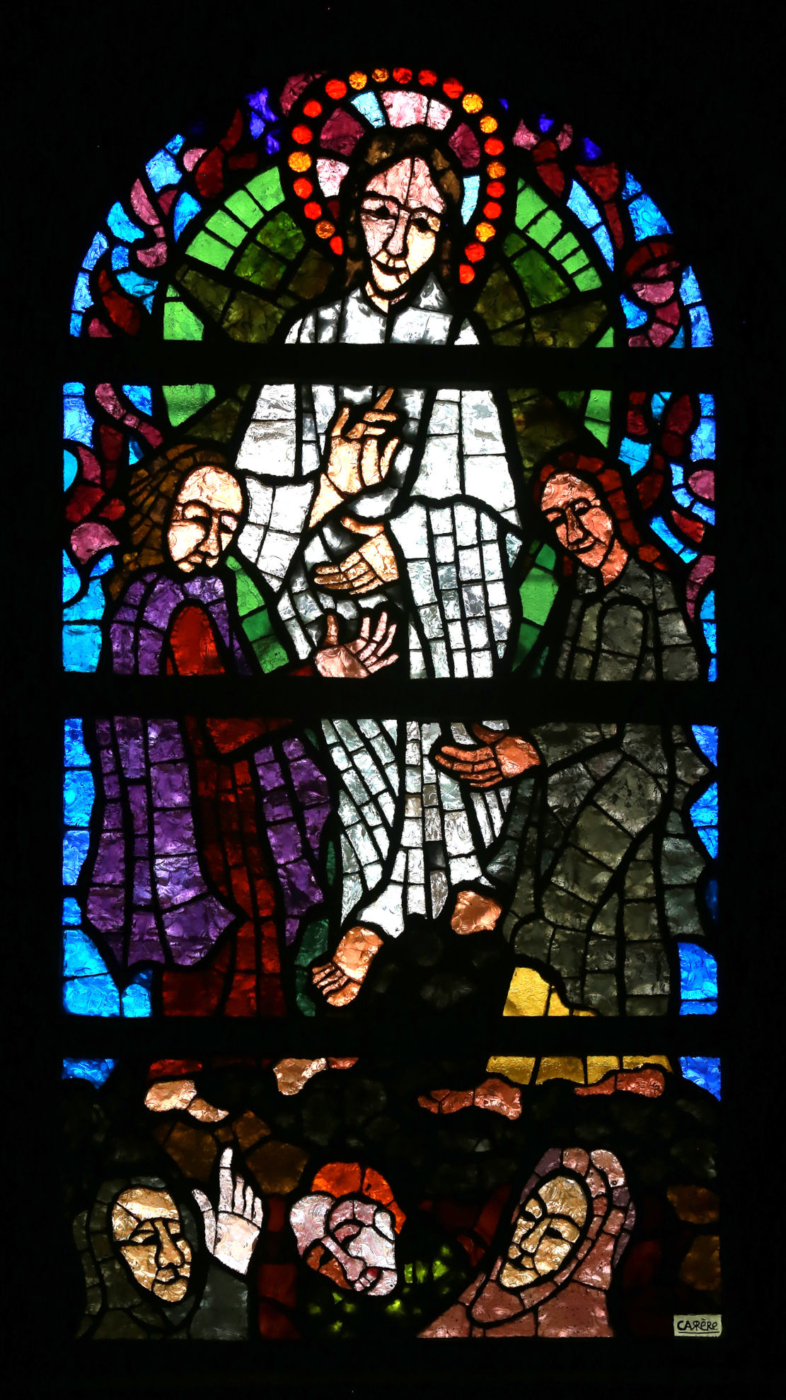
Christ in Majesty stained glass window
This is the third stained glass window, measuring 5 metres in height, and as with the others, Charles Carrère created both the colour model and the illustration. A few changes can be seen between the colour model and the cardboard: in colour, the bull and lion at the top and the eagle and man underneath, while the reverse is true in the execution cardboard. The feet of Christ are not visible in the colour drawing, but they are in the execution card. The skull and snake have also changed.
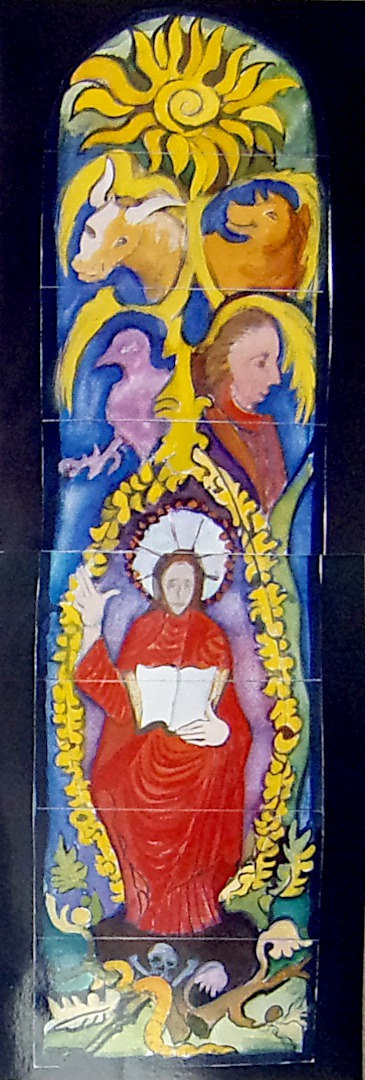


This stained glass window shows Christ in Majesty in a mandorla. Unlike the Christ Pantocrator, the Christ in Glory, of which only the bust is visible, the Christ in Majesty is depicted in full. He is holding the Book of Scripture and his right hand is raised with the palm facing forward.
The index and middle fingers are raised, the thumb is open and the last two fingers are closed. This gesture is a blessing that appeared very early in Christian art. It could also be defined as a gesture for speaking, as used by the rhetorician. And here,” explains the Master Glassmaker, “the three fingers show the Trinity (Father, Son and Holy Spirit).
Christ conquered death: a skull can be seen at his feet. Christ also conquered evil: the serpent Satan is lifeless at his feet.
This tetramorph recalls Ezekiel’s vision in the Book of Ezekiel and John’s vision in Revelation 4, 7-8. Above Christ, the tetramorph illustrating the 4 evangelists: The eagle represents John, the angel-man is Matthew, the bull turned ox is Luke and the lion is Mark. The tetramorph is placed around the representation of Christ in majesty and sums up the four greatest moments in the life of Jesus: The eagle for his ascent into heaven, symbol of the soul, The man: God became incarnate, The bull, the animal of sacrifice, The lion of the temptation in the desert “Be sober, be vigilant. Your adversary, the devil, prowls about like a roaring lion, seeking whom he may devour” Peter 5-8. The sun above, represented as a flower, is the symbol of Christ.
Photo©FrédéricBAMBA
The Last Ends stained glass window
This is the 4th large 5-metre high stained glass window, “The Last Ends”, a reminder of Christian hope and the afterlife in our world. Here is the colour model and the execution card. You can already see an evolution between the colour mock-up and the construction drawing.


The stained glass window of the Last Ends refers to the first epistle to the Corinthians: 1Cor 15,54-58 O death, where is your victory?
In the centre of the window we see the scales illuminated by the sun of justice. It is the hand of St Michael the Archangel holding the scales. At the top, there is a heart, the symbol of love. At the top left, the hand that blesses.
On either side of the fire, the hands raised are those of the dead who are ascending to heaven to escape the flames of hell.
The candle is lit and the faithful pray for the repose of their souls.
At the very bottom is the chained lion, roaring and looking for someone to devour.
Photo©FrédéricBAMBA
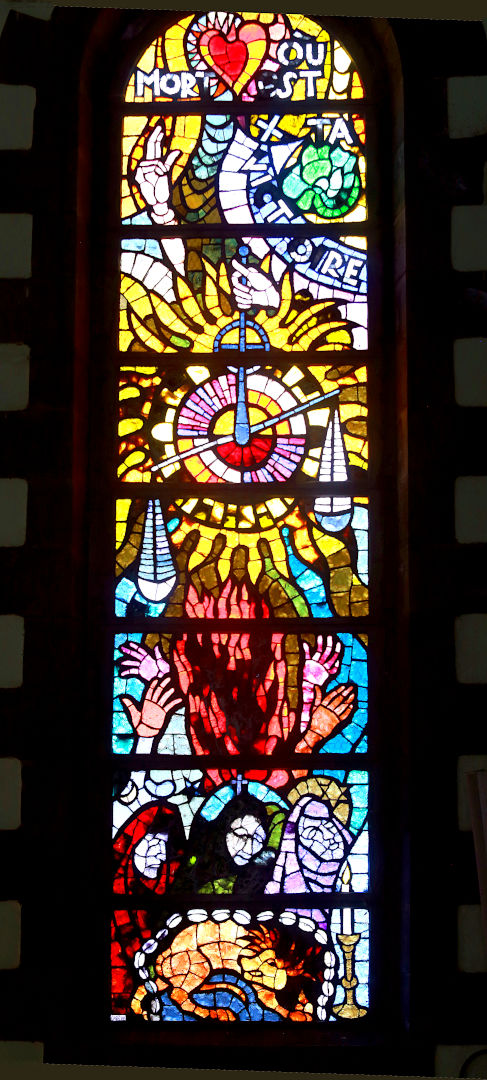
Rosace Saint André de La Réunion
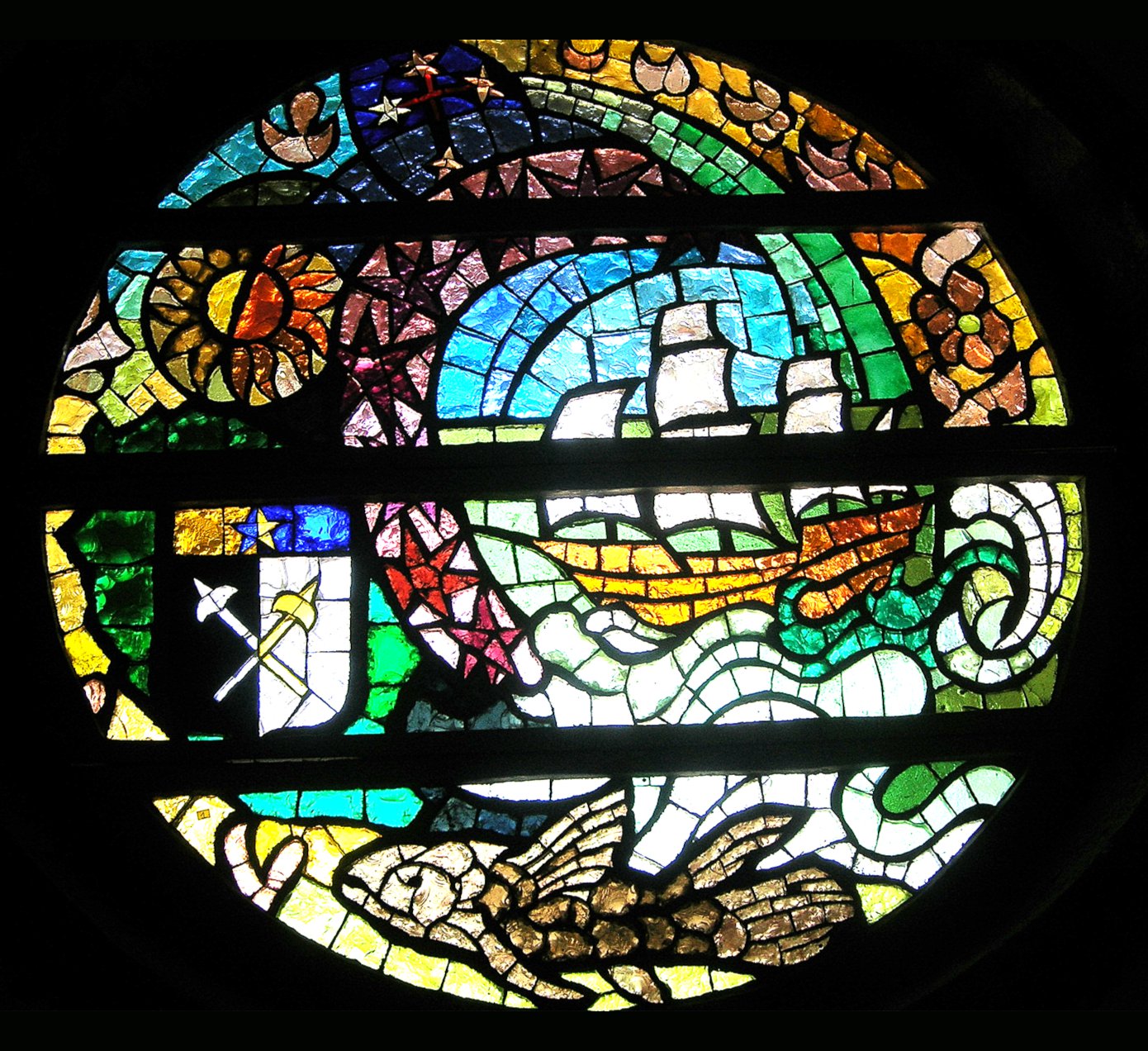
The rose window represents La Réunion, where the first settlers arrived by boat, as well as the old coat of arms of the town of Saint André on a black and white background: “Multis gentibus cor unum” (many races, one heart).
Below, the coelacanth, a large fish renowned on Réunion.
Thanks to Frédéric Bamba who sent us some superb photos from La Réunion!
This post is also available in: French

